

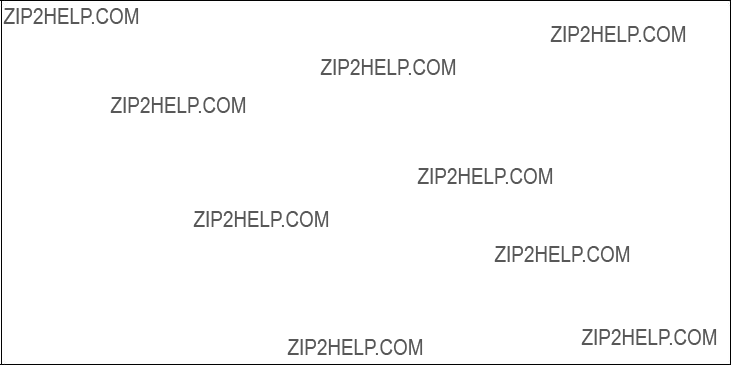
LICENSING AGREEMENT
1.Copyright
The copyright for this software is owned by Fuji Photo Film Co., Ltd. (???FUJI???).
2.Prohibitions
You may not (1) copy, modify or adapt any or all parts of this software; (2) provide this software to a third party in the from of a copy, loan or gift; or (3) reverse engineer this software.
3.
Should the software fail to function properly due to a defect in the medium within 7 (seven) days after the date of purchase, please return the software to the place of purchase for a replacement.
4.Exemptions
(1)FUJI does not guarantee that this software will achieve the results intended by the purchaser.
(2)FUJI is not liable for problems that arise from the quality or performance of this software.
(3)FUJI is not liable for damages incurred directly or indirectly by the purchaser or a third party through the use of this software.
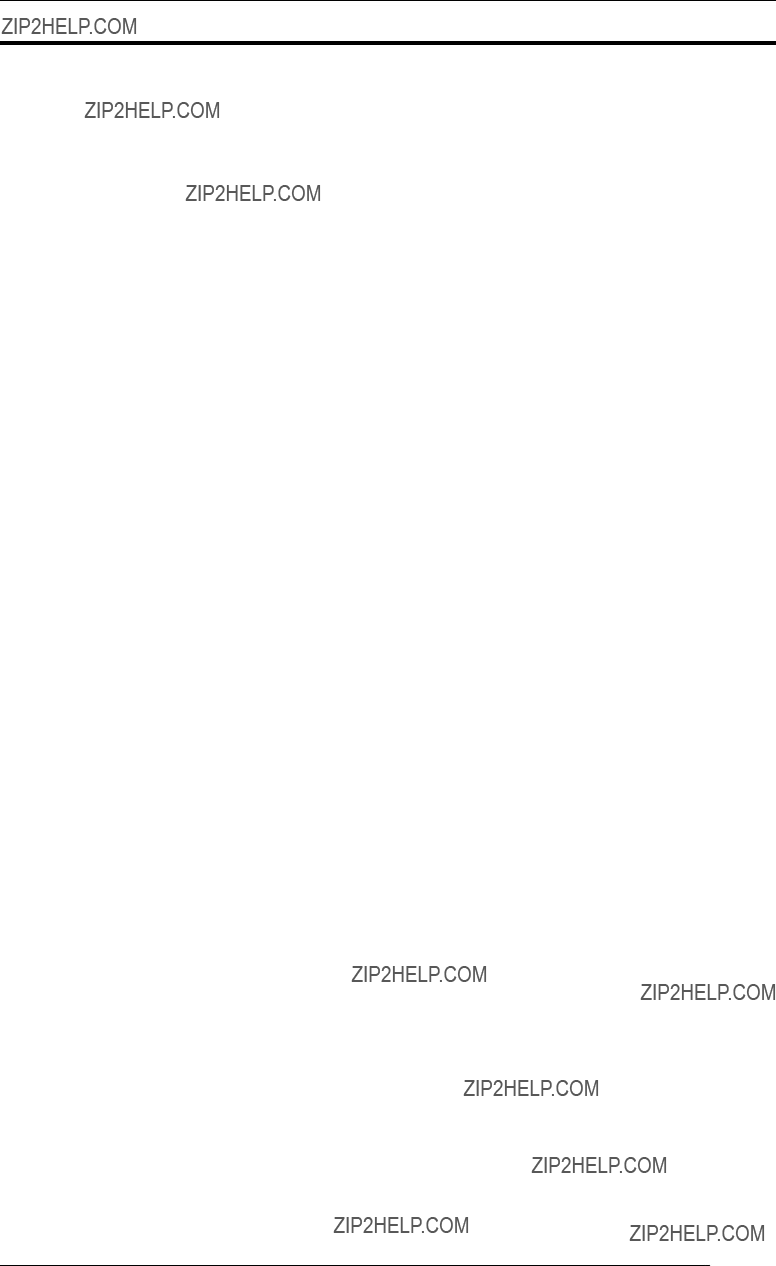
INTRODUCTION
???This manual gives procedures for installing and using the PICTROGRAPHY 3500 printer driver, as well as several precautions.
???This software requires a SCSI adapter. Before installation, check that a functioning SCSI adapter has been installed in your computer.
???For issues directly involving Windows, Macintosh, or other operating systems, please refer to the manual provided with the particular operating system.
???The functions and screen contents presented in this manual are subject to change as software may be upgraded at any time. Screen contents and
???This manual may not be copied or transcribed in whole or in part without prior approval from the publisher.
???Adobe Photoshop is a trademark of Adobe Systems Inc. in several nations.
???Microsoft, Windows, and Windows NT are registered trademarks of Microsoft Corp. in the US and other countries.
???Macintosh, Mac OS, and AppleTalk are registered trademarks of Apple Computer Inc.
???PICTROGRAPHY is a registered trademark of Fuji Photo Film.
???Other product and company names are registered trademarks of the respective companies.
1

CONTENTS
2

3
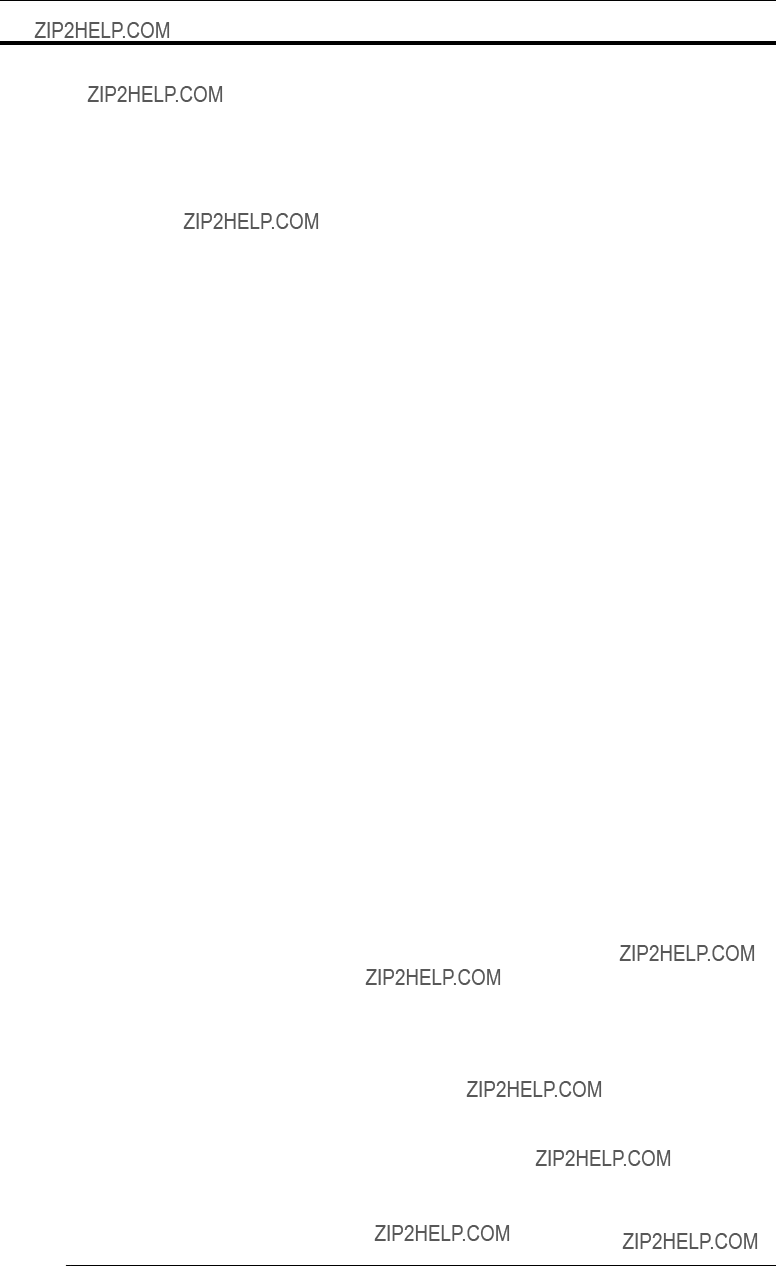
1. PRINTER DRIVER
1.1 Outline
The PICTROGRAPHY 3500 is capable of delivering ultrahigh,
The PICTROGRAPHY 3500 Printer Driver is a driver software com- patible with such diverse computer environments as Macintosh, Win- dows 95/98, Windows NT 4.0, Windows 2000 and Windows XP among others.
1.2 Features
The PICTROGRAPHY 3500 Printer Driver has the following fea- tures:
???Supports a variety of OSes.
Allows output of prints from diverse OS environments including Macintosh, Windows 95/98, Windows NT 4.0, Windows 2000 and Windows XP, etc.
???
Comes with user interfaces matched to varying OS environments and allows the user to make fine adjustments to color outputs on the driver.
1.3Operating Environment
The PICTROGRAPHY 3500 Printer Driver runs in the personal com- puter operating environments detailed below:
Hardware
[Windows]
???Model: IBM
???CPU: Pentium 133 MHz or newer
???Memory: 64MB or more
???HDD: 96MB or more of available space
???SCSI adapter: Adapter made by ADAPTEC
[Macintosh]
???Model: Power Macintosh or greater
???Memory: 5MB or more of available space
???HDD: 64MB or more of available space
???SCSI adapter: SCSI port provided standard on the main body
Adapter made by ADAPTEC (Power Domain 2940UW, Power Domain 2930U, SCSIConnect2906).
Software
[Windows]
???ASPI Manager (ASPI Manager needs to be compatible with the selected SCSI adapter) Ver. 4.01 or higher recommended
???OS
Windows 95: Some versions impose restrictions
Windows 98: With Service Pack 1 installed or second edition or later.
Windows NT 4.0: With Service Pack 5 or later installed Windows 2000
Windows XP
[Macintosh]
???OS
Mac OS 7.6.1 Mac OS 8.1 Mac OS 8.6
Mac OS 9 (With some restrictions) Mac OS X 10.2.1 or later
4
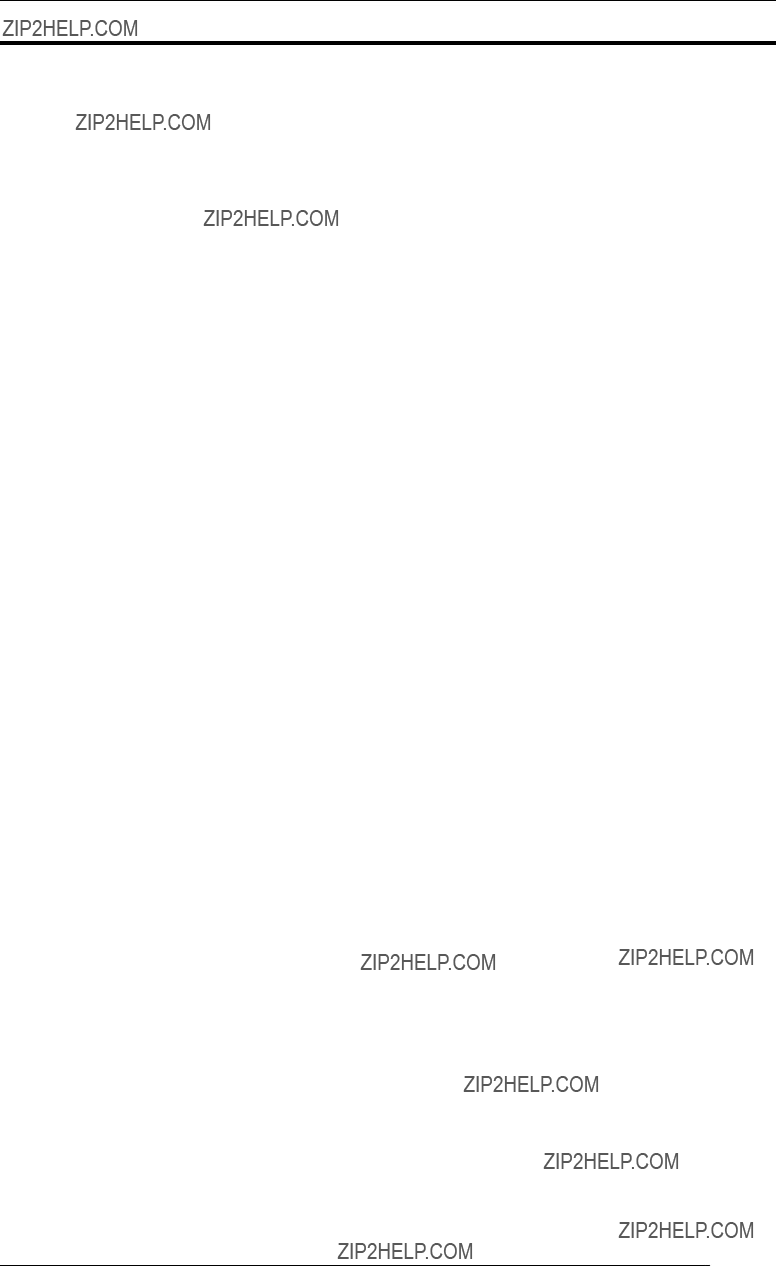
2. PRECAUTIONS FOR USING THE PRINTER DRIVER
This section explains various items that need to be set up before you can use the printer driver.
2.1 Windows
2.1.1Setting up the PICTROGRAPHY
The PICTROGRAPHY 3500 is shipped from the factory with its device type set to [Printer]. To use the printer with Windows 95 (Ver- sion 4.00.950 or 4.00.950a), the device type setting on the PICTROGRAPHY 3500 primary unit must be changed to [Proces- sor]. Notice that, if you attempt to use the printer without changing this setting, Windows 95 will not operate properly.
For information on setting this parameter, see the PICTROGRAPHY 3500 instruction manual.
2.1.2Installing the ASPI Manager
The printer driver requires a SCSI connection between the PICTROGRAPHY 3500 and your computer. In turn, the SCSI inter- face requires installation of the ASPI Manager software in addition to the SCSI driver.
For information on installing the ASPI Manager, see the instruction manual supplied with your SCSI interface adapter.
*With Windows 95 or Windows 98, ASPI Manager is automati- cally installed along with system software. Note that ASPI Man- ager is not automatically installed with Windows NT 4.0, Win- dows 2000 or Windows XP. Even with Windows 95/98, we rec- ommend manually installing the latest version of ASPI Manager to improve software reliability.
*Use ASPI Manager Version 4.01 or later.
*If you are currently running Windows 2000 or Windows XP, in- stall ASPI Manager Version 4.70 or later.
2.1.3Network setup (for network printing)
If you plan to print across a network, you need to make the appropri- ate network settings on your computer. This subsection covers only the setup items required to this end. For information on setting these parameters, see the instruction manual supplied with your copy of Windows.
2.1.3.1Setting up a PC to function as a server
???Windows 95/98:
Install a network protocol compatible with your network environ- ment (e.g. TCP/IP).
To allow printer sharing, install the Microsoft network sharing ser- vices and make the appropriate settings. Click [File and Printer Sharing] in the [Network] dialog displayed when you
???Windows NT 4.0:
Install a protocol compatible with your network environment (e.g. TCP/IP).
???Windows 2000
Install a network protocol compatible with your network environ- ment (e.g. TCP/IP).
???Windows XP
Install a network protocol compatible with your network environ- ment (e.g. TCP/IP).
2.1.3.2Setting up a PC as a network client
Install the same protocol installed on the server.
2.2 Macintosh (Mac OS 9 or earlier)
2.2.1Setting up AppleTalk (to enable network printing)
You need to set up AppleTalk to enable network (Ethernet) printing.
Set up both the server and client computers for AppleTalk, specify- ing [Ethernet] for the output path (port to be used).
For information on setting this parameter, refer to the Macintosh in- struction manual.
2.2.2Setup for file sharing (to enable network printing)
Make the appropriate settings for file sharing if you plan to print across a network (Ethernet).
These settings should permit client computers to access files on the server. For these settings, refer to your Macintosh instruction manual.
2.3 Macintosh (Mac OS X)
You need to set up TCP/IP to enable network (Ethernet) printing. Perform setup so as to permit the use of TCP/IP.
5
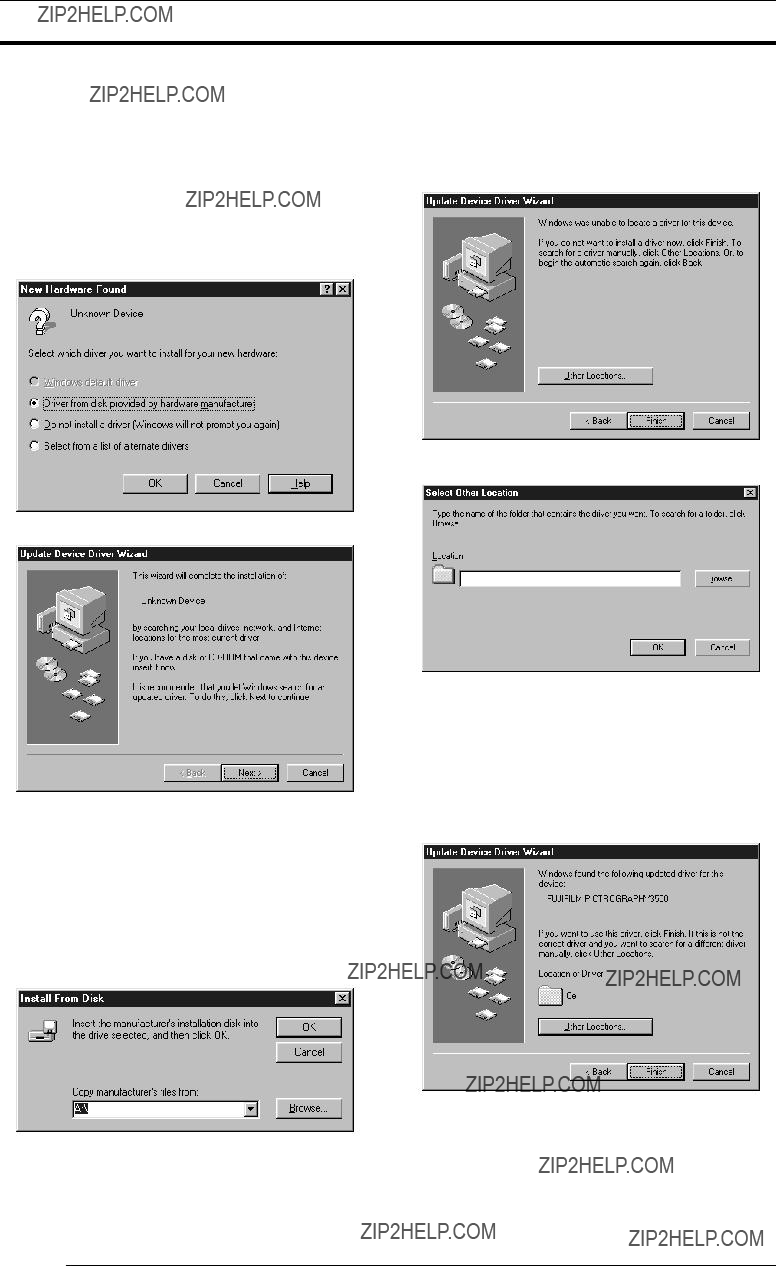
3. INSTALLATION
3.1 Windows 95
3.1.1Connecting the PICTROGRAPHY 3500 for the first time
Unless the printer driver is already installed, when you start your computer with PICTROGRAPHY 3500 for the first time, one of the following windows is displayed as Windows 95 starts, depending on your specific version of Windows 95.
??? Screen (1)
??? Screen (2)
In this case, install the printer driver as explained below. If you would rather install the printer driver at some later time, click the [Cancel] button.
??? If Screen (1) appears:
1.Insert the PICTROGRAPHY3500 Printer Driver
2.Select [Driver Provided by Hardware Manufacturer] and click the [OK] button.
The [Install From Disk] dialog box is displayed.
3.For the remainder of the installation procedure, skip to step 7 in "3.1.2 For Local Printing".
??? If Screen (2) appears:
1.Insert the PICTROGRAPHY3500 Printer Driver
2.Click the [Next] button. The following appears:
3.Click the [Other Locations...] button.
The [Select Other Location] dialog box is displayed.
4.Enter the following location in the [Location] field. For CE Type:
E:\Win95_98English\CE (*If your
E:\Win95_98English\UC (*If your
5.Click the [OK] button. The following appears:
for CE type
6
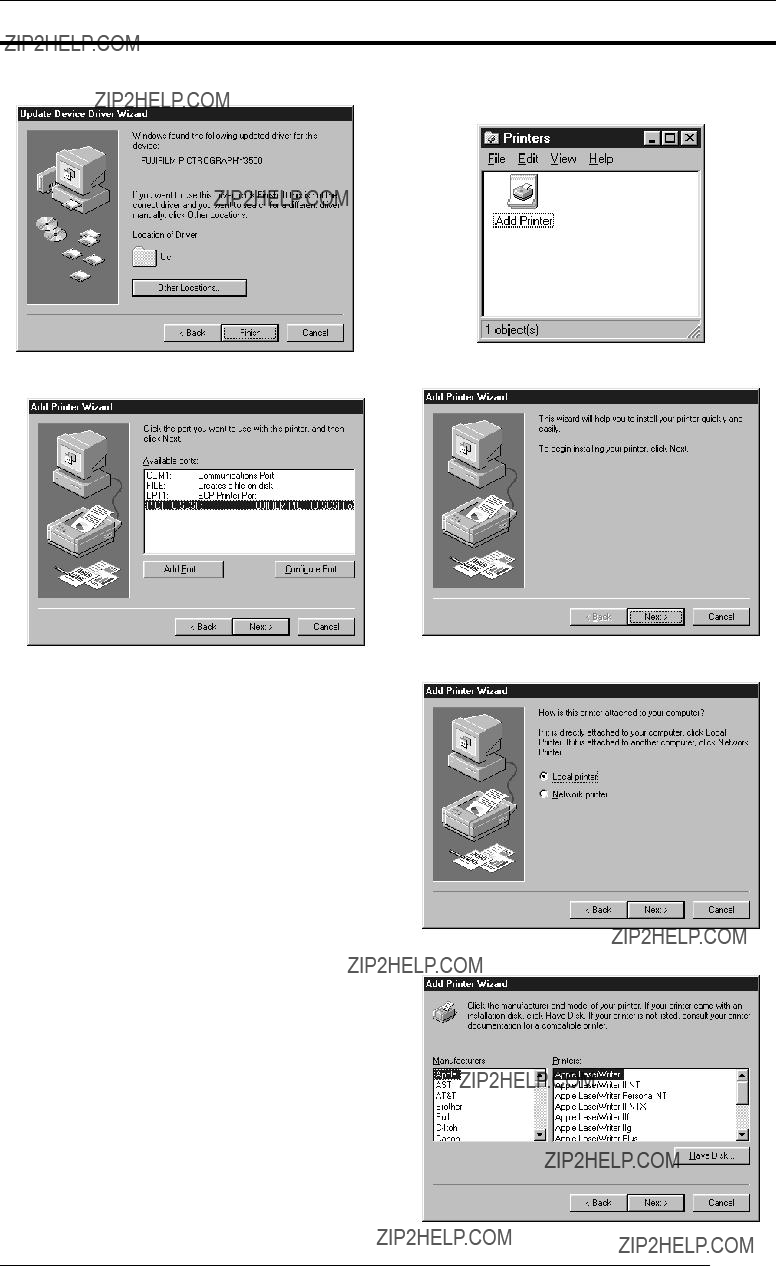
3. INSTALLATION
for UC type
6.Click the [Finish] button.
The following is displayed when the file is copied:
In certain cases, the following prompt may be displayed when you copy the file: [The file ???PG35. DRV??? on Windows 95 CD- ROM could not be found. Insert Windows 95
If you see this message, enter the following location and press the [OK] button:
For CE Type:
E:\Win95_98English\CE (*If your
E:\Win95_98English\UC (*If your
7.For the remainder of the installation procedure, skip to step 10 in "3.1.2 For Local Printing".
3.1.2For Local Printing
To enable local printing, install the printer driver as follows.
1.Insert the PICTROGRAPHY3500 Printer Driver
2.Select [Setting] > [Printer] from the [Start] menu. The [Printers] folder window appears.
3.
The [Add Printer Wizard] dialog box is displayed.
4.Click the [Next] button. The following appears:
5.Select [Local printer] and click the [Next] button. The following appears:
7

3. INSTALLATION
6.Click the [Have Disk] button.
The [Install From Disk] screen appears.
7.Enter the following location in the [Copy manufacturer???s files from:] field.
For CE Type:
E:\Win95_98English\CE (*If your
E:\Win95_98English\UC (*If your
8.Click the [OK] button. The following appears:
9.Confirm that "FUJIFILM PICTROGRAPHY3500" appears in the [Printers:] field and click the [Next] button.
The following is displayed when the file is copied:
10.Select [PICTRO SCSI: FUJIFILM PICTRO SCSI Port ] in [Available ports:] and click the [Next] button.
The following appears:
11.Specify a printer name in the field currently displaying the name of the default printer. You may select any printer in place of the default printer.
If another printer is already installed, you will be prompted as follows: "Use this printer as the default printer?" Select [Yes] or
[No].
After completing printer selection, click the [Finish] button.
12.If installation of the printer driver is complete, the icon for the new printer will appear in the [Printers] folder, as shown below.
13.Restart the computer.
3.1.3For Network Printing
For network printing, install printer drivers in both the server and client computers by the respective procedures described below.
3.1.3.1Installing to the server
1.To install the printer driver, follow steps 1. through 12. in "3.1.2 For Local Printing".
2.Select [Setting] > [Printer] from the [Start] menu. The [Printers] folder window appears.
8

3. INSTALLATION
3.Click the [FUJIFILM PICTROGRAPHY3500] icon and click [Sharing...] on the [File] menu.
4.The [FUJIFILM PICTROGRAPHY3500 Properties] dialog box is displayed.
5.Select [Shared As:].
6.Set a Share Name. The default Share Name is currently displayed on the screen. You may select any printer in place of the default printer. Enter the comment and password, if required.
After defining a Share Name, click the [OK] button.
7.Restart the computer.
3.1.3.2Installing to client computers
1.The server should be started beforehand.
The printer driver must be installed in the server, and the server and client should be linked across a network.
2.Select [Setting] > [Printer] from the [Start] menu. The [Printers] folder window appears.
3.
The [Add Printer Wizard] dialog box is displayed.
4.Click the [Next] button. The following appears:
5.Select [Network printer] and click the [Next] button. The following appears:
9

3. INSTALLATION
6.Make the appropriate setting in [Network path or queue name:].
Specify the server name to which the PICTROGRAPHY 3500 is connected on the network and its Share Name. For example, if the computer name for the server is SERVER and the Share Name for the PICTROGRAPHY 3500 connected to the server is PG3500, enter the following:
\\SERVER\PG3500
You can also interactively select the printer by clicking the
[Browse...] button.
Clicking the [Browse...] opens the [Browse for Printer] win- dow.
7.When the [Browse for Printer] window opens and the network computer names appear,
Once you have selected the sharing name for the printer, click the [OK] button.
You will be returned to the screen in step 5. The selected Share Name for the printer will appear in the [Network path or queue name:] field.
8.After entering the [Network path or queue name:], click the [Next] button.
The following appears:
9.Specify a printer name in the field currently displaying the name of the default printer. You may select any printer in place of the default printer.
If another printer is already installed, you will be prompted as follows: "Use this printer as the default printer?" Select [Yes] or
[No].
After completing printer selection, click the [Next] button. The following appears:
10.Following installation of the printer driver, select whether or not to print a test page. Make your selection and click the [Fin- ish] button.
11.If you selected to print the test page in step 10. above, the fol- lowing screen appears. If the test page prints without problems, click the [Yes] button. Otherwise, click the [No] button and per- form troubleshooting, following the instructions provided on- screen.
12.If installation of the printer driver is complete, the icon for the new printer will appear in the [Printers] folder window, as shown below:
13. Restart the computer.
10

3. INSTALLATION
3.1.4Uninstall
The printer driver uninstall procedure is described below:
1.Select [Setting] > [Printer] from the [Start] menu. The [Print- ers] folder window appears.
2.Click the [FUJIFILM PICTROGRAPHY3500] icon, then click [Delete] from the [File] menu.
You will be prompted to confirm the delete. Click the [Yes] but- ton.
3.You may also be prompted as follows: "These files are no longer needed. Delete?" If so, click the [Yes] button.
4.This completes the uninstall.
3.2Windows 98
3.2.1Connecting the PICTROGRAPHY 3500 for the first time
Unless the printer driver is already installed, when you start up your computer with the PICTROGRAPHY 3500 connected for the first time, the following screen is displayed when Windows 98 starts.
You can install the printer driver by the procedure described below. If you would rather install the printer driver at some later time, click the [Cancel] button.
1.Insert the PICTROGRAPHY3500 Printer Driver
2.Click the [Next] button. The following appears:
3.Select [Search for best driver for your device [Recommended] and click the [Next] button.
The following appears:
4.Check [Specify a location] and enter the following location in the field where the search location is specified.
For CE Type:
E:\Win95_98English\CE (*If your
E:\Win95_98English\UC (*If your
5.Click the [Next] button. The following appears:
for CE type
for UC type
11
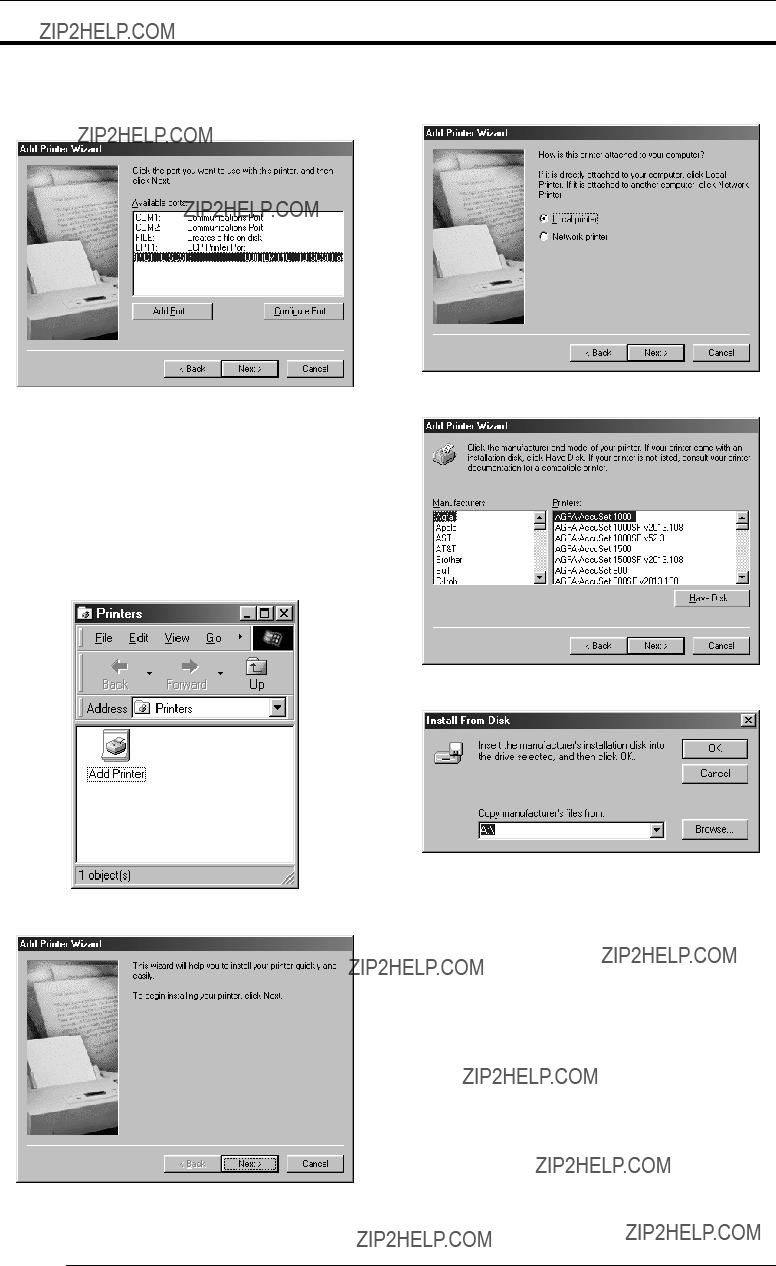
3. INSTALLATION
6.Confirm that the FUJIFILM PICTROGRAPHY3500 driver file has been detected. Click the [Next] button.
The following is displayed when the file is copied:
7.For the remainder of the installation procedure, skip to step 10 in "3.2.2 For Local Printing".
3.2.2For Local Printing
To enable local printing, install the printer driver as follows.
1.Insert the PICTROGRAPHY3500 Printer Driver
2.Select [Setting] > [Printer] from the [Start] menu. The [Printers] folder window appears.
3.
The [Add Printer Wizard] dialog box is displayed.
4.Click the [Next] button. The following appears:
5.Select [Local printer] and click the [Next] button. The following appears:
6.Click the [Have Disk] button.
The [Install From Disk] dialog box is displayed.
7.Enter the following location in the [Copy manufacturer???s files from:] field.
For CE Type:
E:\Win95_98English\CE (*If your
E:\Win95_98English\UC (*If your
12

3. INSTALLATION
8.Click the [OK] button. The following appears:
9.Confirm that "FUJIFILM PICTROGRAPHY3500" appears in the [Printers:] field and click the [Next] button.
The following is displayed when the file is copied:
10.Select [PICTRO SCSI: FUJIFILM PICTRO SCSI Port] in [Available ports:] and click the [Next] button.
The following appears:
11.Specify a printer name in the field currently displaying the name of the default printer. You may select any printer in place of the default printer.
If another printer is already installed, you will be prompted as follows: "Use this printer as the default printer?" Select [Yes] or
[No].
After completing printer selection, click the [Finish] button.
12.If installation of the printer driver is complete, the icon for the new printer appears in the [Printers] folder window.
13.Restart the computer.
3.2.3For Network Printing
For network printing, install printer drivers in both the server and client computers by the respective procedures described below.
3.2.3.1Installing to the server
1.To install the printer driver, follow steps 1. through 12. in "3.2.2 For Local Printing".
2.Select [Setting] > [Printer] from the [Start] menu. The [Printers] folder window appears.
3.Click the [FUJIFILM PICTROGRAPHY3500] icon and click [Sharing...] on the [File] menu.
13

3. INSTALLATION
4.The [FUJIFILM PICTROGRAPHY3500 Properties] dialog box is displayed.
3.
The [Add Printer Wizard] dialog box is displayed.
4.Click the [Next] button. The following appears:
5.Select [Shared As:].
6.Set a Share Name. The current default Share Name is displayed. You may select any printer in place of the default printer. Enter the comment and password, if required.
After defining the Share Name, click the [OK] button.
7.Restart the computer.
3.2.3.2Installing to client computers
1.Start the server computer.
The printer driver should already be installed in the server, and the server and client should be linked across a network.
2.Select [Setting] > [Printer] from the [Start] menu. The [Printers] folder window appears.
5.Select [Network printer] and click the [Next] button. The following appears:
14

3. INSTALLATION
6.Make the appropriate setting in [Network path or queue name:]. Specify the server to which the PICTROGRAPHY 3500 is con- nected on the network and its sharing name. For example, if the computer name for the server is SERVER and the Share Name for the PICTROGRAPHY 3500 connected to the server is PG3500, enter the following:
\\SERVER\PG3500
You can also interactively select the printer by clicking the
[Browse...] button.
Clicking the [Browse...] opens the [Browse for Printer] win- dow.
7.When the [Browse for Printer] window opens and the network computer names appear,
Once you have selected the Share Name for the printer, click the [OK] button.
You will be returned to the screen in step 5. The selected sharing name for the printer is displayed in the [Network path or queue name:] field.
8.After entering the [Network path or queue name:], click the [Next] button.
The following appears:
9.Specify a printer name in the field currently displaying the name of the default printer. You may select any printer in place of the default printer.
If another printer is already installed, you will be prompted as fol- lows: "Use this printer as the default printer?" Select [Yes] or [No]. After completing printer selection, click the [Next] button.
The following appears:
10.Following installation of the printer driver, select whether or not to print a test page. Make your selection and click the [Fin- ish] button.
11.If you selected to print the test page in step 10. above, the fol- lowing screen appears. If the test page prints without problems, click the [Yes] button. Otherwise, click the [No] button and per- form troubleshooting as instructed
12.If installation of the printer driver is complete, the icon for the new printer will appear in the [Printers] folder window, as shown below:
13. Restart the computer.
15

3. INSTALLATION
3.2.4Uninstall
The printer driver uninstall procedure is described below:
1.Select [Setting] > [Printer] from the [Start] menu. The [Print- ers] folder window is displayed.
2.Click the [FUJIFILM PICTROGRAPHY3500] icon, then click [Delete] from the [File] menu.
You will be prompted to confirm the delete. Click the [Yes] but- ton.
3.You may also be prompted as follows: "These files are no longer needed. Delete?" If so, click the [Yes] button.
4.This completes the uninstall.
3.3Windows NT 4.0
Installing printer drivers in Windows NT 4.0 must be performed by a user assigned to the Administrators' Group.
3.3.1For Local Printing
To enable local printing, install the printer driver as follows.
1.Insert the PICTROGRAPHY3500 Printer Driver
2.Select [Setting] > [Printer] from the [Start] menu. The [Printers] folder window is displayed.
4.Select [My Computer] and click the [Next] button. The following appears:
5.Click the [Add Port...] button.
The [Printer Ports] dialog box appears:
6.Click the [New Monitor...] button.
The [Installing Print Monitor] dialog box is displayed.
3.
The [Add Printer Wizard] dialog box is displayed.
16

3. INSTALLATION
7.Enter the following location in the [Copy manufacturer???s files from:] field.
For CE Type:
E:\Win95_98English\CE (*If your
E:\Win95_98English\UC (*If your
8.Confirm that [FUJIFILM PICTRO SCSI Port] appears in the [Available Printer Ports:] field and click the [New Port...] but- ton.
The following appears when the file is copied.
9.Click the [Close] button. The following appears:
10.Confirm that [PICTRO SCSI:] in [Available ports:] is checked and click the [Next] button.
The following appears:
11.Click the [Have Disk] button.
The [Install From Disk] dialog box is displayed.
12.Enter the following location in the [Copy manufacturer???s files from:] field.
For CE Type:
E:\Win95_98English\CE (*If your
E:\Win95_98English\UC (*If your
13.Click the [OK] button. The following appears:
17

3. INSTALLATION
14.Confirm that "FUJIFILM PICTROGRAPHY3500" appears in the [Printers:] field and click the [Next] button.
The following appears.
15.Specify a printer name in the field currently displaying the name of the default printer. You may select any printer in place of the default printer.
If another printer is already installed, you will be prompted as follows: "Use this printer as the default printer?" Select [Yes] or
[No].
After completing printer selection, click the [Next] button. The following appears:
16.Select [Not shared] and click the [Next] button. The following appears:
17.Following installation of the printer driver, select whether or not to print a test page. Make your selection and click the [Fin- ish] button.
The file is copied.
18.If you selected to print the test page in step 17. above, the fol- lowing screen appears. If the test page prints without problems, click the [Yes] button. Otherwise, click the [No] button and per- form troubleshooting as instructed
19.If installation of the printer driver is complete, the icon for the new printer will appear in the [Printers] folder window, as shown below:
20. Restart the computer.
18
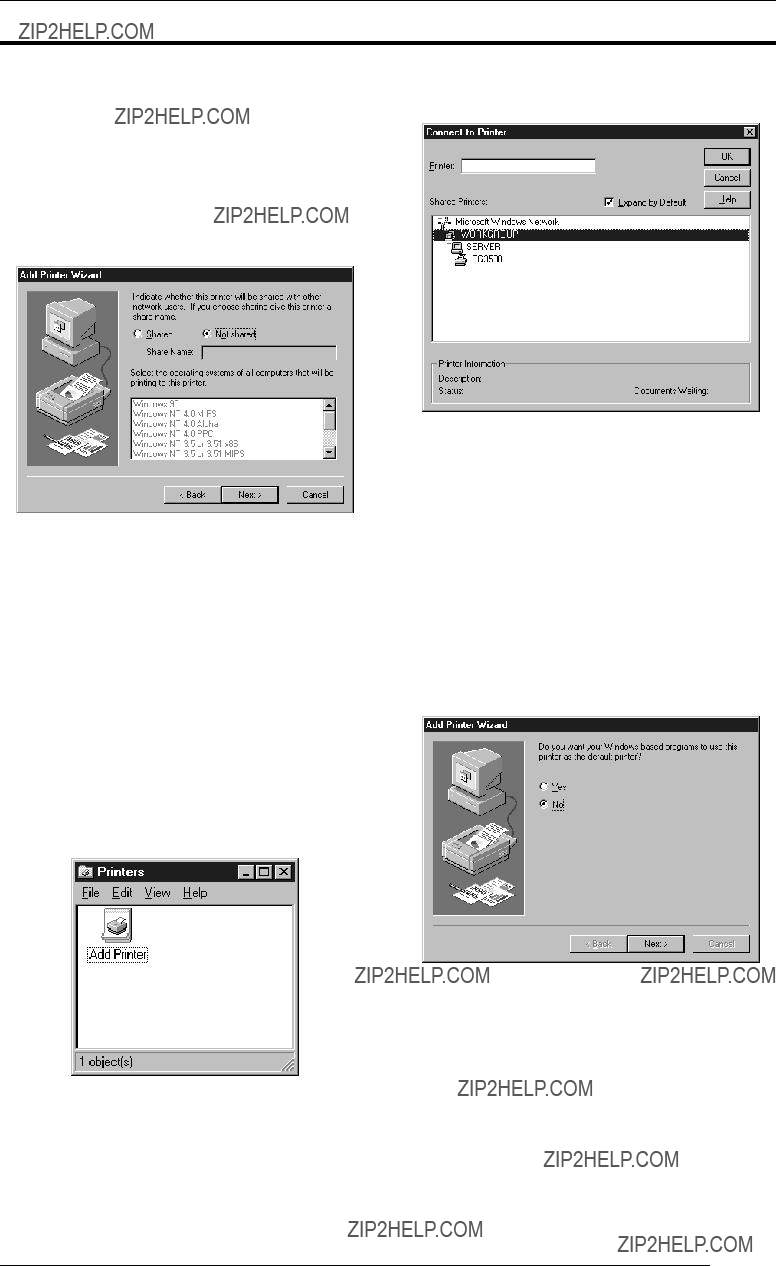
3. INSTALLATION
3.3.2For Network Printing
For network printing, install printer drivers in both the server and client computers by the respective procedures described below.
3.3.2.1Installing to the server
1.To install the printer driver, follow steps 1. through 15. in "3.3.1 For Local Printing".
The following appears:
Then continue installation by the procedure described below.
2.Select [Shared].
Set a Share Name. The default Share Name is currently displayed. You may select any printer in place of the default printer. After defining the sharing name, click the [Next] button.
3.Continue installation of the printer driver in accordance with the procedure described in step 17. and the subsequent steps in "3.3.1 For Local Printing".
3.3.2.2Installing to client computers
1.Start the server computer.
The printer driver should already be installed in the server, and the server and client computers should be linked across a net- work.
2.Select [Setting] > [Printer] from the [Start] menu. The [Printers] folder window is displayed.
3.
The [Add Printer Wizard] dialog box is displayed.
4.Select [Network printer server] and click the [Next] button. The [Connect to Printer] dialog box appears:
5.Enter a network path in the [Printer:] field and specify the server to which the PICTROGRAPHY 3500 is connected on the net- work and its Share Name.
For example, if the computer name for the server is SERVER and the Share Name for the PICTROGRAPHY 3500 connected to the server is PG3500, enter the following:
\\SERVER\PG3500
You can also select the name of a computer connected to the network shown in the [Shared Printers:] field. In this case,
[Printer:] field.
Once the network path is entered in the [Printer:] field, click the [OK] button.
6.If another printer is already installed, the following screen ap- pears.
19

3. INSTALLATION
7.Choose either [Yes] or [No]. Click the [Next] button. The following appears:
8.Click the [Finish] button.
If installation of the printer driver is complete, the icon for the new printer will appear in the [Printers] folder window.
9.Restart the computer.
3.3.3Uninstall
The printer driver uninstall procedure is described below:
1.Delete the printer.
Click to select [Setting] > [Printer] from the [Start] menu. The [Printers] folder window is displayed.
2.Click the [FUJIFILM PICTROGRAPHY3500] icon, then click [Delete] from the [File] menu.
You will be prompted to confirm the delete. Click the [Yes] but- ton.
3.Delete [PICTRO SCSI Port].
In the [Printers] folder window, click [Server Properties] from the [File] menu.
The [Print Server Properties] dialog box is displayed.
4.Click the [Ports] tab.
Click [PICTRO SCSI:] from the list of [Ports on this Server], then click the [Delete Port] button.
You will be prompted to confirm the deletion. Click the [Yes] button.
3.4 Windows 2000
Note the following when installing the printer driver in Windows 2000:
*You must be logged on as a user assigned to the Administrators??? Group.
*In the [File signature verification] field in the [Driver Signing Option] dialog box, check to make sure that either
[Control Panel] > [System] > [Hardware] tabs, then click the [Driver Signing] button.
3.4.1For Local Printing
To enable local printing, install the printer driver as follows:
1.Insert the PICTROGRAPHY3500 Printer Driver
2.Click to select [Settings] > [Printers] from the [Start] menu. The [Printers] folder window is displayed.
3.Install [PICTRO SCSI Port].
Click [File] > [Server Properties] in the [Printers] folder. This displays the [Print Server Properties] dialog box. Click the [Ports] tab.
The following appears.
20
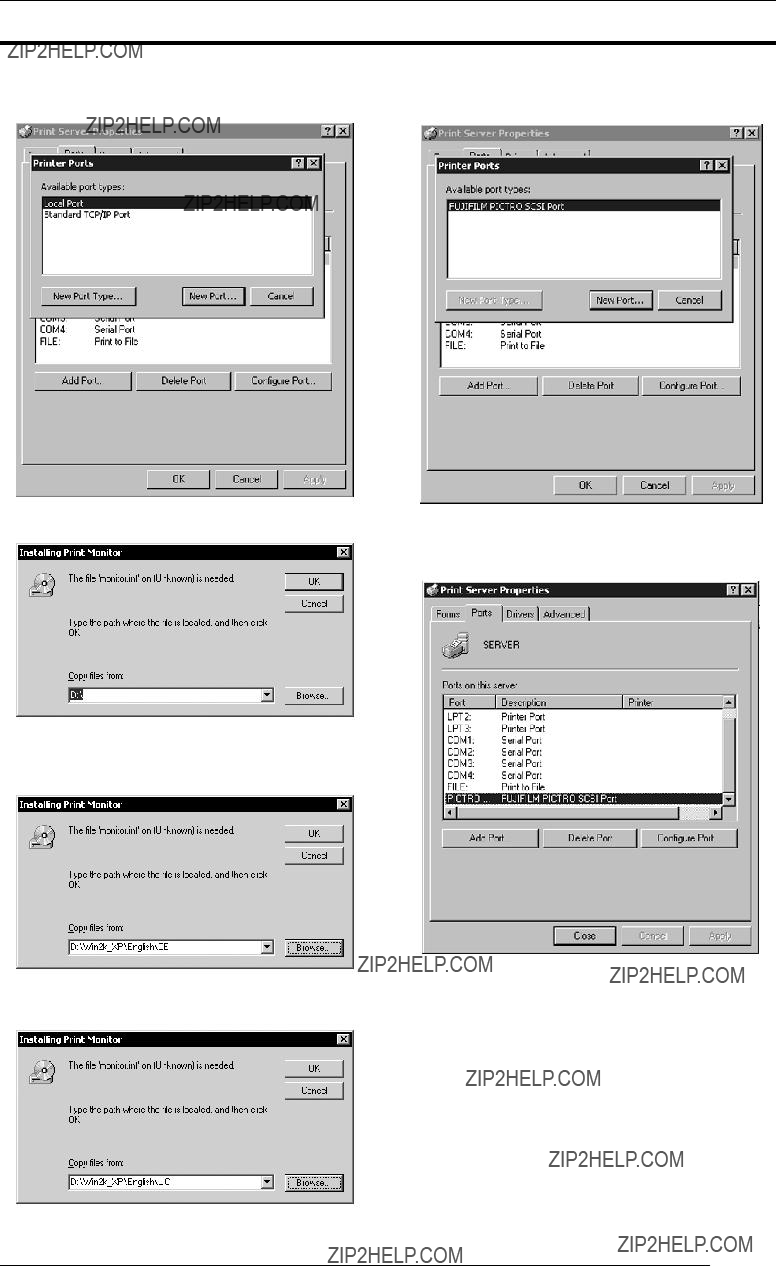
3. INSTALLATION
4.Click the [Add Port] button.
The [Printer Ports] dialog box is displayed.
5.Click the [New Port Type].
The [Installing Print Monitor] dialog box is displayed.
6.Enter CE Type
D:\Win2k_XP\English\CE (*If your
Click the [OK] button.
The following appears.
7.Confirm that [FUJIFILM PICTRO SCSI Port] appears in the [Available port types;] field, and then click the [New Port] button.
The following is displayed when the file is copied.
UC Type
D:\Win2k_XP\English\UC (*If your
8.Confirm that [PICTRO SCSI:] appears in [Ports on this server], and then click the [Close] button.
This completes the installation of [PICTRO SCSI Port].
21
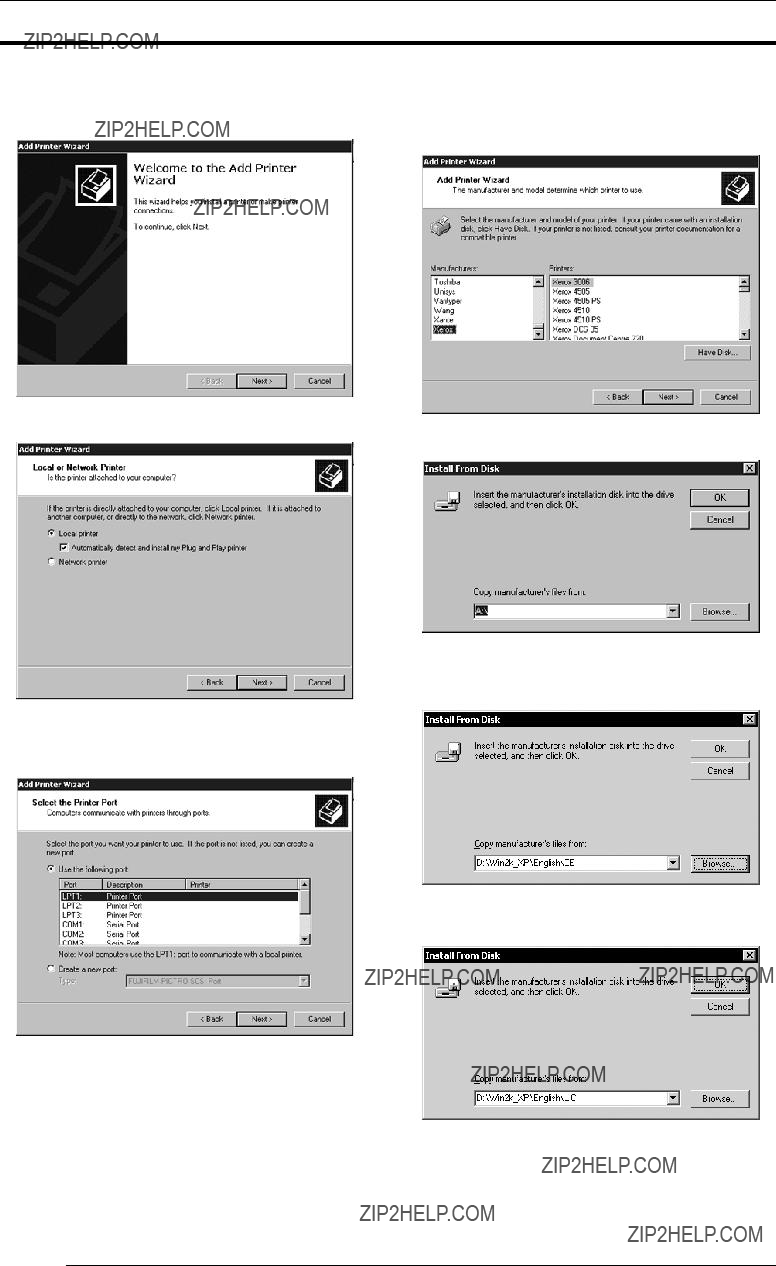
3. INSTALLATION
9.Now install the printer.
Click the [Add Printer] icon in the [Printers] folder window. The [Add Printer Wizard] dialog box is displayed.
10.Click the [Next] button. The following appears.
11.Select [Local Printer] and uncheck [Automatically detect and install my plug and Play printer].
Click the [Next] button. The following appears.
12.Select [Use the following port], and then click to select [PICTRO SCSI:] from the list of ports.
Click the [Next] button. The following appears.
13.Click the [Have Disk] button.
The [Install From Disk] dialog box is displayed.
Enter: CE Type
D:\Win2k_XP\English\CE (*If your
UC Type
D:\Win2k_XP\English\UC (*If your
22

3. INSTALLATION
14.Click the [OK] button. The following appears.
15.Confirm that "FUJIFILM PICTROGRAPHY3500" appears in the [Printers:] field and click the [Next] button.
The following appears.
16.Specify a printer name in the field where the name of the default printer is currently displayed. You may select any printer to replace the default printer.
If another printer is installed, you will be prompted as follows: "Use this printer as the default printer?", select [Yes] or [No]. After completing printer selection, click the [Next] button. The following appears.
17.Select [Do not share this printer], and then click the [Next] button.
The following appears.
18.Choose to print or not print a test page following the completion of printer driver installation. Make your selection and click the [Next] button.
The following appears.
19.Click the [Finish] button.
In certain cases, this will display the [Digital Signature Not Found] dialog box, prompting you as follows: ???Continue the installation???? (figure below). If this message appears, click [Yes] to continue with the installation.
The file is copied.
23

3. INSTALLATION
20.If you chose to print the test page in step 18, the following screen is displayed.
If the test page prints without problems, click the [Yes] button. Otherwise, click the [Troubleshoot] button and perform trouble- shooting as instructed
21.If installation of the printer driver finishes without problems, the icon for the new printer appears in the [Printers] folder win- dow, as shown below:
22.Restart the computer.
This completes the installation of the printer driver.
3.4.2For Network Printing
For network printing, install printer drivers on both server and client computers by the following procedures:
???Precautions on the running of Windows NT 4.0 on the server computer and Windows 2000 on the client computer.
When the printer driver is installed under the following condi- tions, the Windows NT 4.0 printer driver may end up being in- stalled on a machine running Windows 2000. To avoid this, take care to follow the installation procedures given below when in- stalling printer drivers under these conditions.
[Conditions]
*The server computer is running Windows NT 4.0.
*The client computers are running Windows 2000. The Windows 2000 PG3500 printer driver is not yet installed on the client com- puters.
[Installation Procedure]
(1)Install the printer driver to the server computer (Windows NT 4.0) as described in "3.3.2.1 Installing to the server."
(2)Install the printer driver to client computers as described in "3.4.2.2 Installing to client computers." Do not execute [Print Test Page].
(3)Click to select [Setting] > [Printer] from the [Start] menu. This displays the [Printers] folder. Click the [FUJIFILM PICTROGRAPHY3500] icon and click [Properties] in the [File] menu.
This displays the [FUJIFILM PICTROGRAPHY3500 Prop- erties] dialog box.
(4)Click the [Advanced] tab. Click the [New Driver] button.
This displays the [Add Printer Driver Wizard] dialog box.
(5)Click the [Next] button.
From this point, continue installing the printer driver as described in 13. , with subsequent steps as described in "3.4.1 For Local Printing".
3.4.2.1Installing to the server
1.When you are running Windows 2000 on the server computer, install the printer driver to the server by doing steps 1 through 16 in "3.4.1 For Local Printing".
The following appears.
Then continue the installation by following the procedures de- scribed below.
2.Select [Share as].
Set a share name. The default share name is currently displayed. You may select any printer to replace the default printer.
After defining the share name, click the [OK] button. The following appears.
24

3. INSTALLATION
3.Enter the location of the printer in the [Location] field and the description of the printer in the [Comment] field, or click the [Next] button without entering anything.
4.Continue installation of the printer driver according to the pro- cedure described in step 18 and subsequent steps in "3.4.1 For Local Printing".
3.4.2.2Installing to client computers
1.Start the server computer.
The printer driver should already be installed on the server, and the server and client should be linked across a network.
2.Click to select [Settings] > [Printers] from the [Start] menu. The [Printers] folder window is displayed.
3.
The [Add Printer Wizard] dialog box is displayed.
4.Click the [Next] button. The following appears.
5.Select [Network Printer], then click the [Next] button. The [Locate Your Printer] dialog box is displayed.
6.Select [Type the printer name, or click Next to browse for a printer].
Enter a network path in the [Name] field, or click the [Next] button without entering anything.
If you enter a network path, specify the server to which the PICTROGRAPHY 3500 is connected on the network and its share name. For example, if the computer name of the server is "SERVER" and the share name for the PICTROGRAPHY 3500 connected to the server is "PG3500", enter the following:
\\SERVER\PG3500
If you entered nothing in the [Name] field, the following screen is displayed:
25

3. INSTALLATION
The [Shared Printer] field displays the names of the computers connected to the network.
This selection sets the network path in the [Printer] field. After confirming that the network path has been set in the [Printer] field, click the [Next] button.
7.The following screen is displayed.
8.Select [Yes] or [No], and then click the [Next] button. The following screen is displayed.
9.Click the [Finish] button.
If installation of the printer driver finishes without problems, the icon for the new printer appears in the [Printers] folder win- dow.
10.Restart the computer.
This completes the installation of the printer driver.
3.4.3. Uninstall
The printer driver uninstall procedure is described below.
1.Start by deleting the printer.
Click to select [Setting] > [Printer] from the [Start] menu. The [Printers] folder window is displayed.
2.Click the [FUJIFILM PICTROGRAPHY3500] icon, and then click [Delete] from the [File] menu.
You will be prompted to confirm the deletion. Click the [Yes] button.
3.Delete [PICTRO SCSI Port].
In the [Printers] folder window, click [Server Properties] from the [File] menu.
The [Print Server Properties] dialog box is displayed.
4.Click the [Ports] tab.
Click [PICTRO SCSI:] in the list of [Ports on this Server], and then click the [Delete Port] button.
You will be prompted to confirm the deletion. Click the [Yes] button.
This completes the uninstall of the printer driver.
3.5Windows XP
Note the following when installing the printer driver in Windows XP:
*You must be logged on as a user assigned to the Administration Group.
*In the [What action do you want Windows to take?] field in the [Driver Signing Options] dialog box, check to make sure that either [Ignore - Install the software anyway and don???t ask for my approval] or [Warn - Prompt me each time to choose an action] is specified. To display the [Driver Signing Options] dialog box, click the [Control Panel] > [System] > [Hardware] tabs, then click the [Driver Signing] button.
26

3. INSTALLATION
3.5.1For Local Printing
To enable local printing, install the printer driver as follows.
1.Insert the PICTROGRAPHY3500 Printer Driver
2.Click to select [Printers and Faxes] from the [Start] menu. The [Printers and Faxes] folder window is displayed.
5.Click the [New Port Type].
The [Installing Print Monitor] dialog box is displayed.
6.Enter
CE Type
D:\Win2k_XP\English\CE (*If your
3.Install [PICTRO SCSI Port].
Click [File] > [Server Properties] in the [Printers and Faxes] folder.
This displays the [Print Server Properties] dialog box. Click the [Ports] tab.
The following appears.
4.Click the [Add Port] button.
The [Printer Ports] dialog box is displayed.
UC Type
D:\Win2k_XP\English\UC (*If your
Click the [OK] button.
The following appears.
27

3. INSTALLATION
7.Confirm that [FUJIFILM PICTRO SCSI Port] appears in the [Available port types] field, click the [New Port] button, and then click the [Close] button.
The following is displayed when the file is copied.
8.Confirm that [PICTRO SCSI:] appears in [Ports on this server], and then click the [Close] button.
This completes the installation of [PICTRO SCSI Port].
9.Now install the printer.
Click the [Add a printer] icon in the [Printers and Faxes] folder window.
The [Add Printer Wizard] dialog box is displayed.
10.Click the [Next] button. The following appears.
11.Select [Local printer attached to this computer] and uncheck [Automatically detect and install my Plug and Play printer]. Click the [Next] button.
The following appears.
12.Select [Use the following port], and then click to select
[PICTRO SCSI: (FUJIFILM PICTRO SCSI Port)] from the list of ports.
28

3. INSTALLATION
13.Click the [Next] button. The following appears.
14.Click the [Have Disk] button.
The [Install From Disk] dialog box is displayed.
15.Enter:
CE Type
D:\Win2k_XP\English\CE (*If your
UC Type
D:\Win2k_XP\English\UC (*If your
16.Click the [OK] button. The following appears.
17.Confirm that "FUJIFILM PICTROGRAPHY3500" appears in the [Printers:] field and click the [Next] button.
The following appears.
18.Specify a printer name in the field where the name of the default printer is currently displayed. You may select any printer to re- place the default printer.
If another printer is installed, you will be prompted as follows: "Use this printer as the default printer?", select [Yes] or [No]. After completing printer selection, click the [Next] button. The following appears.
29

3. INSTALLATION
19.Select [Do not share this printer], and then click the [Next] button.
The following appears.
22.If you chose to print the test page in step 20, the following screen is displayed.
If the test page prints without problems, click the [Yes] button. Otherwise, click the [Troubleshoot] button and perform trouble- shooting as instructed
20.Choose to print or not print a test page following the completion of printer driver installation. Make your selection and click the [Next] button.
The following appears.
23.If the installation of the printer driver finishes without problems, the icon for the new printer appears in the [Printers and Faxes] folder window, as shown below.
21.Click the [Finish] button.
In certain cases, this will display the [Hardware Installation] dialog box, prompting you as the figure below. If this message appears, click [Yes] to continue with the installation.
The file is copied.
24.Restart the computer.
This completes the installation of the printer driver.
3.5.2For Network Printing
For network printing, install printer drivers on both server and client computers by the following procedures:
???Precautions on the running of Windows NT 4.0 on the server computer and Windows XP on the client computer.
When the printer driver is installed under the following condi- tions, the Windows NT 4.0 printer driver may end up being in- stalled on a machine running Windows XP. To avoid this, take care to follow the installation procedures given below when in- stalling printer drivers under these conditions.
[Conditions]
*The server computer is running Windows NT4.0.
*The client computers are running Windows XP. The Windows XP PG3500 printer driver is not yet installed on the client com- puters.
30
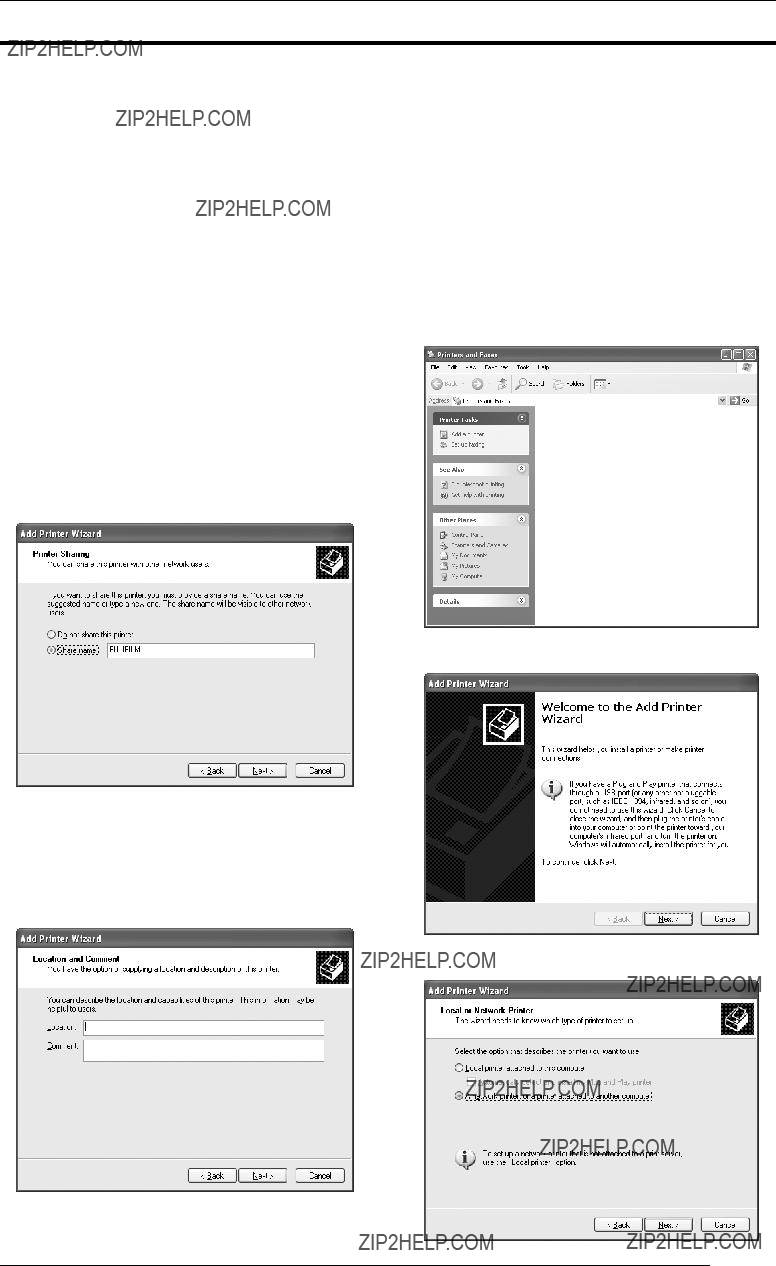
3. INSTALLATION
[Installation Procedure]
(1)Install the printer driver to the server computer (Windows NT 4.0) as described in "3.3.2.1 Installing to the server."
(2)Install the printer driver to the client computers as described in "3.5.2.2 Installing to client computers." Do not execute [Print Test Page].
(3)Click to select [Printers and Faxes] from the [Start] menu. This displays the [Printers and Faxes] folder. Click the
[FUJIFILM PICTROGRAPHY3500] icon and then click [Prop- erties] in the [File] menu.
This displays the [FUJIFILM PICTROGRAPHY3500 Prop- erties] dialog box.
(4)Click the [Advanced] tab. Click the [New Driver] button.
This displays the [Add Printer Driver Wizard] dialog box.
(5)Click the [Next] button.
From this point, continue installing the printer driver as described in 14., with subsequent steps as described in "3.5.1 For Local Printing".
3.5.2.1Installing to the server
1.When you are running Windows XP on the server computer, install the printer driver to the server by doing steps 1 through 18 in "3.5.1 For Local Printing".
The following appears.
Then continue the installation by following the procedures de- scribed below.
2.Select [Share name].
Set a share name. The default share name is currently displayed. You may select any printer to replace the default printer.
After defining the share name, click the [OK] button. The following appears.
3.Enter the location of the printer in the [Location] field and the description of the printer in the [Comment] field, or click the [Next] button without entering anything.
4.Continue installation of the printer driver according to the pro- cedure described in step 20 and subsequent steps in "3.5.1 For Local Printing".
3.5.2.2Installing to client computers
1.Start the server computer.
The printer driver should already be installed on the server, and the server and client should be linked across a network.
2.Click to select [Printers and Faxes] from the [Start] menu. The [Printers and Faxes] folder window is displayed.
3.Click the [Add a printer] icon.
The [Add Printer Wizard] dialog box is displayed.
4.Click the [Next] button. The following appears.
31

3. INSTALLATION
6.Select [Connect to this printer (or to browse for a printer, select this option and click Next)].
Enter a network path in the [Name] field, or click the [Next] button without entering anything.
If you enter a network path, specify the server to which the PICTROGRAPHY 3500 is connected on the network and its share name. For example, if the computer name of the server is "SERVER" and the share name for the PICTROGRAPHY 3500 connected to the server is "PICTRO", enter the following:
\\SERVER\PICTRO
This selection sets the network path in the [Printer] field. After confirming that the network path has been set in the [Printer] field, click the [Next] button.
7.The following appears.
8. Select [Yes] or [No], and then click the [Next] button. The following appears.
If you entered nothing in the [Name] field, the following screen is displayed:
32

3. INSTALLATION
9.Click the [Finish] button.
If installation of the printer driver finishes without problems, the icon for the new printer appears in the [Printers and Faxes] folder window.
3.Copy files 1) through 3) above to the [Extensions] folder in the System Folder. Copy the [PictroGraphy] folder including all its files.
10.Restart the computer.
This completes the installation of the printer driver.
3.5.3Uninstall
The printer driver uninstall procedure is described below.
1.Start by deleting the printer.
Click to select [Printers and Faxes] from the [Start] menu. The [Printers and Faxes] folder window is displayed.
2.Click the [FUJIFILM PICTROGRAPHY3500] icon, and then click [Delete] from the [File] menu.
You will be prompted to confirm the deletion. Click the [Yes] button.
3.Delete [PICTRO SCSI Port].
In the [Printers and Faxes] window, click [Server Proper- ties] from the [File] menu.
The [Print Server Properties] dialog box is displayed.
4.Click the [Ports] tab.
Click [PICTRO SCSI:] in the list of [Ports on this server], and then click the [Delete Port] button.
You will be prompted to confirm the deletion. Click the [Yes] button.
This completes the uninstall of the printer driver.
3.6Macintosh (Mac OS 9 or earlier)
3.6.1For Local Printing
To enable local printing, install the printer driver as follows.
1.Insert the PICTROGRAPHY3500 Printer Driver
2.The following files are contained in the [English] folder within the
1)PictroGraphy 3500
2)PGLauncher
3)PictroGraphy folder (containing PG3500.lib and PGMonitor.)
4)Pictrography3500
4.Copy the file 4) above to the [ColorSync Profiles] folder in the System Folder.
*Since the printer driver supports ColorSync Version 2.5 or later, it may be used with Mac OS 8.5 and later versions.
5.Check to confirm that the files were copied to the following locations:
PictroGraphy 3500 ???System Folder: Extensions PGLauncher
???System Folder: Extensions PictroGraphy folder ???System Folder: Extensions PG3500.lib
???System Folder: Extensions: PictroGraphy PGMonitor
???System Folder: Extensions: PictroGraphy Pictrography 3500
???System Folder: Extensions: ColorSync Profiles
6.Restart the computer.
3.6.2For Network Printing
For network printing, install printer drivers in both the server and client computers by the respective procedures described below.
3.6.2.1Installing to the server
1.Connect the PICTROGRAPHY 3500 to the computer and start. To carry out the procedures described in step 7. and the subse- quent steps, the PICTROGRAPHY 3500 must already be con- nected to the computer.
2.To install the printer driver, follow steps 1. through 5. in "3.6.1 For Local Printing".
3.Open the [Extensions] folder in the System Folder.
33

3. INSTALLATION
4.Click the installed (copied) [PictroGraphy] folder and open the [Sharing] menu in the Finder.
With Mac OS 8.5 or later versions, select the [File] > [View Information] > [Sharing] menu in the Finder.
With earlier Mac OS versions, select the [File] > [Sharing] menu in the Finder.
The following screen appears:
5.Check in [Share this item and its contents].
To allow users to read and write to the [PictroGraphy] folder, set [Privilege] for the owner and users who will print to [Read/ Write].
Close the window when setup is complete.
6.Restart the computer.
7.As the Macintosh restarts, the Apple menu [Chooser] will open.
8.Click [PictroGraphy 3500]. The following screen appears.
9.Click [ID: n] (the
10.Turn [Background printing:] to [On].
11.Confirm that [AppleTalk] is [Active] and close [Chooser].
3.6.2.2Installing to client computers
1.The server should be started beforehand.
The server should already have printer drivers installed, with sharing settings set in the [PictroGraphy] folder. The server should also be connected to the PICTROGRAPHY 3500 and to any client computers on the network.
2.To install the printer driver, follow steps 1. through 6. in "3.6.1 For Local Printing".
3.Open [Chooser] from the Apple menu. The following screen appears:
4.Confirm that [AppleTalk] is [Active], click [AppleShare], and select the server.
Click the [OK] button.
The following screen appears.
5.Enter the required items and click the [Connect] button. The following screen appears.
34

3. INSTALLATION
6.Choose the [PictroGraphy] folder and click the [OK] button. This places the server's [PictroGraphy] folder on the desktop.
7.Click [PictroGraphy 3500] in the [Chooser] window.
You will be prompted as follows: "Connection to server not set. Set an appropriate server". Click the [OK] button. If this prompt does not appear and the [Chooser] window remains open, se- lect [Network Printer] and click the [Set] button.
The following screen appears:
8.Choose the [PictroGraphy 3500] folder on the desktop and click the [Selection: PictroGraphy] button.
9.You will be returned to the [Chooser] window. Confirm that
[PictroGraphy 3500] and [Network Printer] are currently se- lected, then close [Chooser].
3.6.3Uninstall
1.Drag the following files previously installed in the [Extensions] folder in the Macintosh System Folder to the Trash box on the desktop.
PictroGraphy 3500 PGLauncher
PictroGraphy folder (with all files found in the folder)
2.Restart the computer.
3.7 Macintosh (Mac OS X)
3.7.1For Local Printing
To enable local printing, install the printer driver by performing the following procedure:
1.Insert the PICTROGRAPHY3500 Printer Driver
2.Open the [Mac OS X] folder on the
3.
The following dialog box appears.
4.Enter the administrator's name and password, and then click the [OK] button.
The following dialog box appears.
35

3. INSTALLATION
5.Click the [Continue] button.
The following dialog box appears.
6.Select a destination volume to install the printer driver and then click the [Continue] button.
The following dialog box appears.
7.Click the [Install] button.
The following dialog box appears.
8.Click the [Continue Installation] button.
When installation is completed, the following appears.
9.Click the [Restart] button to restart the computer.
Installation of PICTROGRAPHY 3500 Printer Driver for Mac OS X is completed.
When the installation of PICTROGRAPHY 3500 Printer Driver for Mac OS X is completed, perform settings for making prints with the PICTROGRAPHY 3500 that is connected to the computer.
10.Confirm that the PICTROGRAPHY 3500 and the computer are connected properly.
11.Turn ON the PICTROGRAPHY 3500 and wait until the "Self Check" message appears on the LCD display.
When network printing is not performed, proceed to Step 14.
12. Select [System Preferences] from the Apple menu.
The [System Preferences] window appears.
36
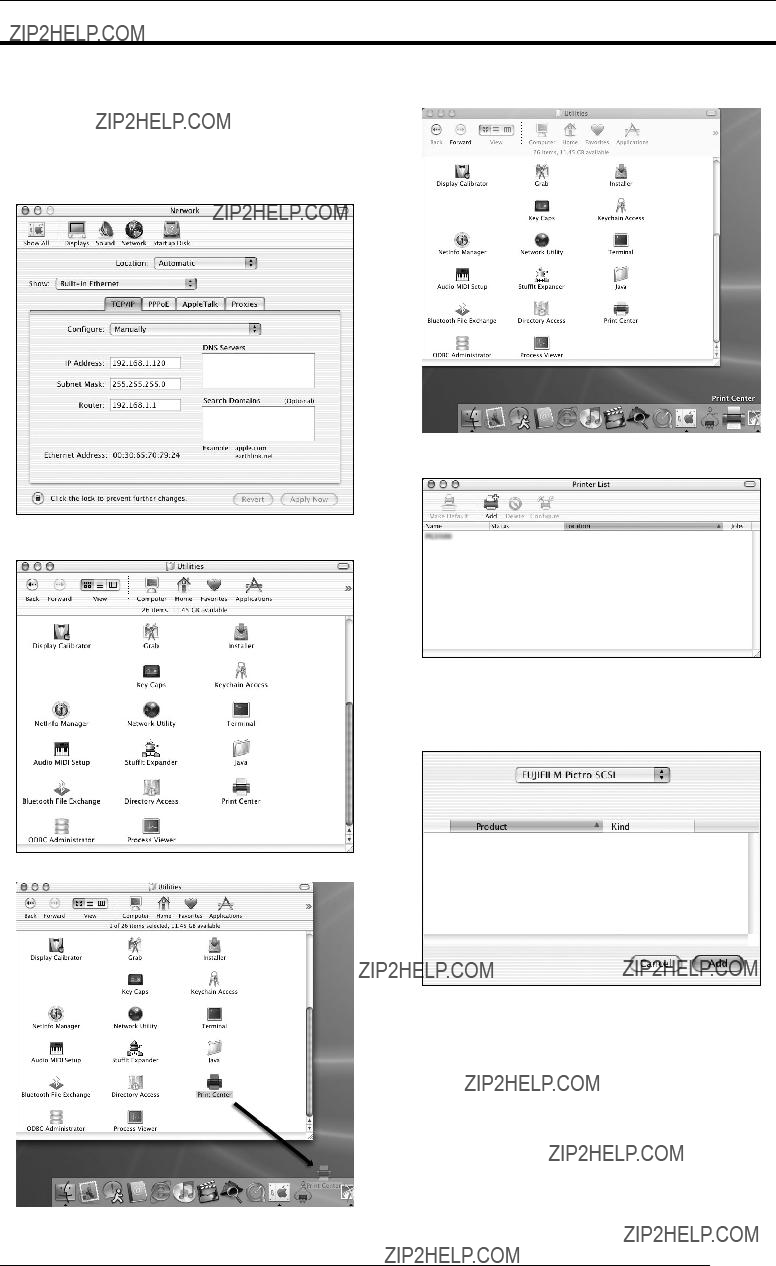
3. INSTALLATION
13.Click [Network].
The [Network] window appears.
Select
The following appears.
Confirm that the TCP/IP settings are correct, and then close the window.
14.Open the [Applications]>[Utilities] folders on the hard disk. The following appears.
15. Drag the [Print Center] file to Dock on the desktop.
The [Print Center] icon is added as an item in Dock.
16.Click the [Print Center] icon in Dock. The [Printer List] window appears.
*If the "You have no printers available" message is displayed, press the [Add...] button and then proceed to the next step.
17.Click the [Add] button. The following appears.
37

3. INSTALLATION
18.Select [FUJIFILM Pictro SCSI] from the
19.Select the PICTROGRAPHY 3500 to be used and then click the [Add] button.
The selected PICTROGRAPHY 3500 is added to the printer list.
20. Select [Quit Print Center] from the [Print Center] menu.
*After adding a printer, be sure to quit Print Center. If print- ing is performed without Print Center quit, the following error message is displayed.
Settings for making prints with the PICTROGRAPHY 3500 are completed.
3.7.2For Network Printing
For network printing, install printer drivers on both server and client computers by the following procedures:
*For network printing, Mac OS X 10.2.1 or later must be running on both server and client computers.
3.7.2.1Installing to the server
1.To install the printer driver, follow Steps 1. through 20. in "3.7.1 For Local Printing".
2.Select [System Preferences] from the Apple menu.
3.The [System Preferences] window appears.
4.Click [Sharing].
The [Sharing] dialog box appears.
38

3. INSTALLATION
5.Click the [Services] tab. The following appears.
6.Mark the [Printer Sharing] check box with a " ??? " and close the
[Sharing] window.
Installation of PICTROGRAPHY 3500 Printer Driver for Mac OS X is completed.
To enter the comment displayed on the [Location] column of the [Printer List] window, perform the following procedure.
7.Click the [Print Center] icon in Dock. The [Printer List] window appears.
8.Click to select the installed PICTROGRAPHY.
9.Select [Show Info] from the [Printers] menu.
The [Printer Info] window appears.
10.Click the [Location] box and enter appropriate comments. The comments entered in this box are also displayed on the cli- ent computer.
3.7.2.2Installing to client computers
1.The server should be started beforehand. The printer driver must be installed in the server, and the server and client must be in the same network segment of TCP/IP.
2.To install the printer driver, follow Steps 1. through 9. in "3.7.1 For Local Printing".
This completes the installation of the printer driver.
To display information on shared printers, perform the following pro- cedure.
3.Click the [Print Center] icon in Dock.
The [Printer List] window appears. Shared printers are displayed with a colored background.
4.Click to select a shared PICTROGRAPHY.
5.Select [Show Info] from the [Printers] menu.
39

3. INSTALLATION
The [Printer Info] window appears.
*Displayed information cannot be changed from the client computers.
3.7.3Uninstall
The printer driver uninstall procedure is shown below.
Even if the uninstall procedure below is performed, the installed printer driver files are not deleted. Normally, there is no need to de- lete the printer driver files.
1.Click the [Print Center] icon in Dock on the desktop. The [Printer List] window appears.
2.Select the printer to be deleted.
3.Click the [Delete] button. The selected printer is deleted.
4.Close the [Printer List] window.
40
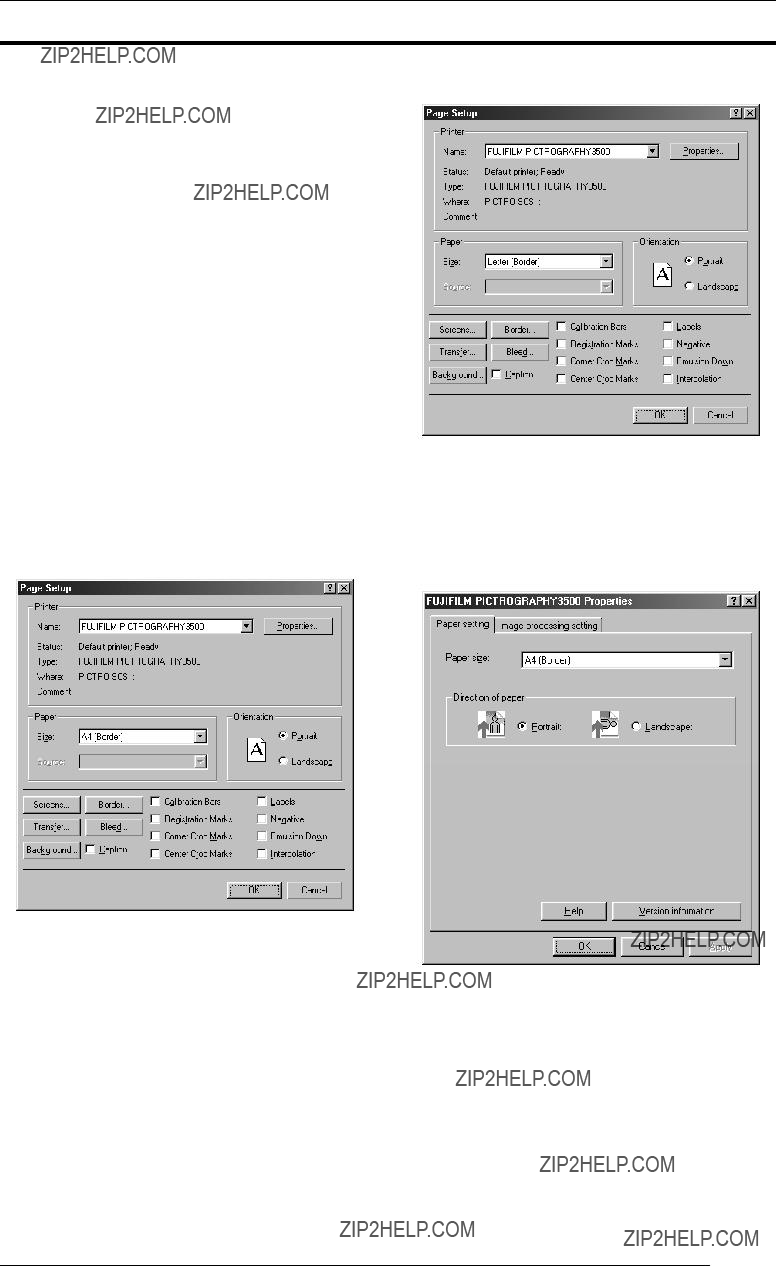
4. USING THE PRINTER DRIVER
4.1 Windows
This subsection describes printing in Windows 95, Windows 98, Win- dows NT 4.0, Windows 2000 or Windows XP environments.
4.1.1Work flow through printing
1.Starting Windows
After verifying that your computer and the PICTROGRAPHY 3500 are connected, first switch on the PICTROGRAPHY 3500, then switch on the computer.
2.Launching an application (preparing print data)
Start the application software and create data to be printed. If you have already created a data file, open that file.
4.1.2Print setup and printing
The specific steps involved in printing vary from application to appli- cation. For more information, see the instruction manual for the ap- plication. The procedure described below uses Adobe PhotoShop 5.0 as an example.
1.Selecting the printer
With the print data file open, click [Page Setup] on the [File] menu.
This displays the [Page Setup] dialog box. for CE type
for UC type
Select [PICTROGRAPHY3500] for [Printer Name:].
2.Selecting a paper size
After choosing the printer name in step 1, click the [Properties] button.
This opens the [FUJIFILM PICTROGRAPHY3500 Proper- ties] dialog box.
for CE type
41

4. USING THE PRINTER DRIVER
for UC type
???Paper size
Select a paper size for printing.
Note that the printable paper size depends on the type of paper currently loaded in the PICTROGRAPHY 3500.
???Direction of paper
Choose Portrait or Landscape.
???[Help] button
Click this button to display Help for the printer driver.
???[Version information] button
Click this button to display the Version Information screen for the printer driver.
3.Image processing setting options
Click the [Image processing setting] tag on the [FUJIFILM PICTROGRAPHY3500 Properties] dialog box to display the following:
???ICM
Check this box if you plan to use the Windows color manage- ment function (ICM).
*ICM is supported only by Windows 98 (Windows 98 with Service Pack 1 and Windows 98 Second Edition), Windows 2000 and Windows XP.
???Matching method
Choose a color matching method (Rendering Intent) with ICM. The following choices are available:
Relative Colorimetric:
Compensates for white color differences, as opposed to absolute reproduction.
Absolute Colorimetric:
Performs colorimetric matching. Colors out- side the color reproduction spectrum are poorly reproduction.
*ICM is supported only by Windows 98 (Windows 98 with Service Pack 1 and Windows 98 Second Edition), Windows 2000 and Windows XP.
???Profile
Choose an ICC profile. Here, select [Pictrography3500 PG- D_ER].
*This
???Brightness
Adjust the print density. Settings toward the right (plus direc- tion) result in lighter prints, while settings toward the left (mi- nus direction) result in darker prints.
???Contrast
Adjust the print contrast. Settings toward the right (plus direc- tion) produce higher contrast, while settings toward the left (minus direction) produce lower contrast.
???Color balance (Red/Green/Blue)
Adjust color balance for prints. Settings toward the right (plus direction) result in higher print density of the color specified, while settings toward the left (minus direction) result in lower print density of the color specified.
???Image process
Select a
42

4. USING THE PRINTER DRIVER
???Gray balance
Select gray gradation and color balance, if Image process is set to OFF.
Gray1 : Suitable for printing with monitors having (2.2/9300) color temperatures of 9300K and ?? 2.2.
Gray2 : Suitable for printing with monitors having (1.8/6500) color temperatures of 6500K and ?? 1.8.
Gray3 (sRGB): Suitable for printing with an sRGB monitor.
4.Printing
Click [Print] from the PhotoShop 5.0 [File] menu. The [Print] dialog box is displayed.
After verifying that [PICTROGRAPHY3500] appears in [Printer:], set up the necessary items and click the [OK] button. Printing is executed.
4.1.3Message Monitor
1.About the Message Monitor
Message Monitor is a network printing utility for client comput- ers.
When network printing occurs, the software monitors the status of the printer (server). If any error is detected, it displays an appropriate alert on the client computer screen.
In Windows 95/98, Message Monitor is launched when network printing occurs. In Windows NT 4.0, Message Monitor is loaded on startup.
An icon appears in the task tray to indicate that Message Moni- tor is running, as shown below:
2.Setting Message Monitor
In the [Interval setting] field, specify the interval at which to check printer (server) status.
4.1.4Spooler
1.Checking the print status
Click to select [Setting] > [Printer] from the [Start] menu. This opens the [Printers] folder window.
[FUJIFILM PICTROGRAPHY3500] icon appearing in the window.
This opens the [FUJIFILM PICTROGRAPHY3500] dialog box.
The document name and status are displayed here for any docu- ment currently printing or waiting to print, if any.
43
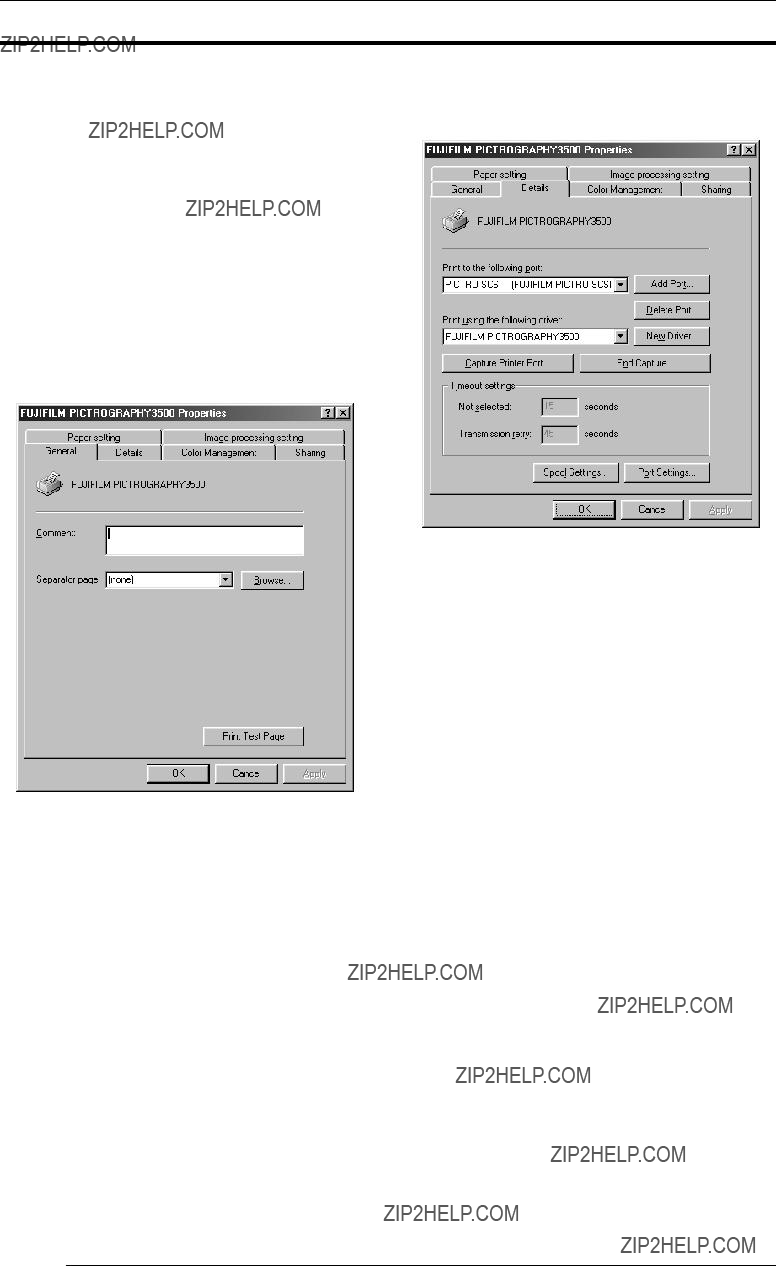
4. USING THE PRINTER DRIVER
2.Canceling printing
In the [FUJIFILM PICTROGRAPHY3500] window, click the document for which you want to cancel printing. Then select [Cancel Print] from the [Document] menu to cancel printing.
*In Windows NT 4.0, Windows 2000 or Windows XP select
[Cancel] on the [Document] menu.
4.1.5Printer folder
Click [File] > [Properties] of the [Printers] folder to view the Printer Properties dialog box. Various printer driver parameters are set here.
4.1.5.1Windows 95/98
Select [Setting] > [Printer] from the [Start] menu. This opens the [Print- ers] folder window. Click the [FUJIFILM PICTROGRAPHY3500] icon, then select [Properties] on the [File] menu.
The [FUJIFILM PICTROGRAPHY3500 Properties] dialog box is displayed.
1.Paper setting
Click the [Paper setting] tab on the [FUJIFILM PICTROGRAPHY3500 Properties] dialog box. For informa- tion on setup items, see ???4.1.2 Print setup and printing???.
The settings entered here are assumed as default values for the application software [Print] command.
2.Image processing setting
Click the [Image processing setting] tab on the [FUJIFILM PICTROGRAPHY3500 Properties] dialog box. For informa- tion on setup items, see ???4.1.2 Print setup and printing???.
The settings entered here are assumed as default values for the application software [Print] command.
3.Details
Click the [Details] tab on the [FUJIFILM PICTROGRAPHY3500 Properties] dialog box to display the following:
???Print to the following port
The port to which the printer is connected or the network printer path is indicated.
???[Add Port...] button
Click this button to add a new port or to specify a new network printer path.
???[Delete Port...] button
Click this button to delete a port from the listing of ports.
???Print using the following driver
Various types of printer drivers are displayed here. Do not change these settings unless absolutely necessary.
???[New Driver...] button
Click this button to add a printer driver.
???[Capture Printer Port...] button
This button is enabled when the computer is connected to a network printer.
Click the button to assign a port to the network drive.
???[End Capture...] button
This button is enabled when the computer is connected to a network printer.
Click this button to clear the port assigned to a network drive.
???Timeout settings
You cannot change this setting when the print output port is
[PICTRO SCSI:(FUJIFILM PICTRO SCSI Port)].
44

4. USING THE PRINTER DRIVER
???[Spool Settings...] button
Click this button to change print spool settings. Clicking the button displays the following window.
No changes need to be made here under normal circumstances.
???Spool print jobs so program finishes printing faster Spooling a document immediately writes the document print data to the hard disk, then sends this data to the printer, quickly releasing an application from print processing.
You can set both the spooling method and spooled data for- mat.
???Print directly to the printer
Print data is sent directly to the printer, without spooling. This may tie up the application until printing is complete.
We recommend spooling print data unless doing so poses spe- cific problems.
This option is disabled for shared printers.
???Enable
Selecting this option enables
*Be sure to choose [Support] with the PICTROGRAPHY 3500 printer driver.
???Disable
Selecting this option disables
???[Setting] button
Click this button to change settings for the port connected to the printer.
No changes need to be made here under normal circumstances. If the print output port is [PICTRO SCSI: (FUJIFILM PICTRO SCSI Port)], click this button to display the [PICTROGRAPHY port information] dialog box.
If the PICTROGRAPHY 3500 is connected to your computer, model number and other information are displayed here. Click the [Setting] button here to display the [port informa- tion] dialog box.
???SCSI ID
Indicates the SCSI ID assigned to the connected PICTROGRAPHY 3500.
???Request timeout value
Set a SCSI communications
If you choose Disabled, no
4.Color Management (Windows 98 only)
Click the [Color Management] tab on the [FUJIFILM PICTROGRAPHY3500 Properties] dialog box.
The following screen appears:
Here, a profile related to the printer may be added or deleted. The profiles for the PICTROGRAPHY 3500 are added during printer driver installation. Do not modify the settings unless ab- solutely necessary.
45

4. USING THE PRINTER DRIVER
4.1.5.2Windows NT 4.0
1.Paper setting (Default value)
Click to select [Setting] > [Printer] from the [Start] menu. This opens the [Printers] folder window. Click the [FUJIFILM PICTROGRAPHY3500] icon, then select [Properties] on the [File] menu.
The [FUJIFILM PICTROGRAPHY3500 Properties] dialog box is displayed.
Click the [Paper setting] tab.
For information on setup items, see ???4.1.2 Print setup and print- ing???.
The settings entered here are assumed as default values for the application software [Print] command.
2.Image processing setting (Default value)
Click the [Image processing setting] tab on the [FUJIFILM PICTROGRAPHY3500 Properties] dialog.
For information on setup items, see ???4.1.2 Print setup and print- ing???.
The settings entered here are assumed as default values for the application software [Print] command.
3.Ports
Select [Setting] > [Printer] from the [Start] menu. This opens the [Printers] folder window. Click the [FUJIFILM PICTROGRAPHY3500] icon, then select [Properties] on the [File] menu.
The [FUJIFILM PICTROGRAPHY3500 Properties] dialog box is displayed.
Click the [Ports] tab.
The following screen appears:
???Print to the following port(s)
The listing of available ports, port monitors for the ports, and printers connected to the ports is displayed.
Print data is output through the first available port among the ports checked.
???[Add Port...] button
Click this button to add a new port.
???[Delete Port] button
Click this button to delete a port.
???[Configure Port...] button
Click this button to make port settings.
There is no need to change the port setting under normal cir- cumstances.
Click the [Configure Port...] button after clicking [PICTRO SCSI:] to display the [PICTROGRAPHY port information] dialog box.
If a PICTROGRAPHY 3500 is connected to your computer, model number and other information are displayed here. Click the [Setting] button to display the [port information] dialog box.
???SCSI ID
Indicates the SCSI ID for the connected PICTROGRAPHY 3500.
???Request timeout value
Set a SCSI communications
If you choose Disabled, no
???Enabled (Enable
This allows the computer to obtain settings and other data from the printer.
*Be sure to check in here when using the PICTROGRAPHY 3500 printer driver.
???Disabled (Enable printer pooling)
This allows to use of multiple identical printers linked with one logic printer.
46

4. USING THE PRINTER DRIVER
4.Scheduling
Click the [Scheduling] tab on the [FUJIFILM PICTROGRAPHY3500 Properties] dialog box. The following screen appears:
This setting does not need to be changed for normal use.
5.Paper setting
Click the [Paper setting] tab on the [FUJIFILM PICTROGRAPHY3500 Properties] dialog box. You can view, but not change the settings displayed here.
6.Image processing setting
Click the [Image processing setting] tab on the [FUJIFILM PICTROGRAPHY3500 Properties] dialog box. You can view, but not change the settings displayed here.
4.1.5.3Windows 2000
1.Paper setting (Print setup)
Click to select [Setting] > [Printer] from the [Start] menu. This opens the [Printers] folder window. Click the [FUJIFILM PICTROGRAPHY3500] icon, then click [Print Setup] on the [File] menu.
The [FUJIFILM PICTROGRAPHY3500 Print Setup] dialog box is displayed.
Click the [Paper setting] tab.
For information on setup items, see Subsection "4.1.2 Print setup and printing."
The settings entered here are used as default values by the appli- cation software [Print] command.
2.
Click the
For information on setup items, see Subsection "4.1.2 Print setup and printing."
The settings entered here are used as default values for the ap- plication software [Print] command.
3.Ports
Click to select [Setting] > [Printer] from the [Start] menu. This opens the [Printers] folder window. Click the [FUJIFILM PICTROGRAPHY3500] icon, then click [Properties] on the [File] menu.
The [FUJIFILM PICTROGRAPHY3500 Properties] dialog box is displayed.
Click the [Ports] tab.
For information on setup items, see "3. Ports in Subsection 4.1.5.2 Windows NT 4.0".
4.Detailed settings
Click the [Advanced] tab in the [FUJIFILM PICTROGRAPHY 3500 Properties] dialog box.
The following appears.
Normally, these settings do not need to be changed.
5.Color management
Click the [Color Management] tab in the [FUJIFILM PICTROGRAPHY3500 Properties] dialog box.
The following appears.
47

4. USING THE PRINTER DRIVER
Here, you can add or delete profiles related to the printer. Note that profiles for the PICTROGRAPHY 3500 were added when the printer driver was installed. Under normal conditions, these settings should not be altered.
6.Paper setting
Click the [Paper setting] tab in the [FUJIFILM PICTROGRAPHY3500 Properties] dialog box. These set- tings can be viewed, but not modified.
7.Image processing setting
Click the [Image processing setting] tab in the [FUJIFILM PICTROGRAPHY3500 Properties] dialog box. These set- tings can be viewed, but not modified.
4.1.5.4Windows XP
1.Paper Setting (Print setup)
Click to select [Printers and Faxes] in the [Start] menu. This opens the [Printers and Faxes] folder window. Click the
[FUJIFILM PICTROGRAPHY3500] icon, and then click [Print Setup] in the [File] menu.
The [FUJIFILM PICTROGRAPHY3500 Print Setup] dialog box is displayed.
Click the [Paper Setting] tab.
For information on setup items, see subsection "4.1.2 Print setup and printing."
The settings entered here are the default values of the applica- tion software???s [Print] command.
2.
Click the
For information on setup items, see subsection "4.1.2 Print setup and printing."
The settings entered here are the default values of the applica- tion software???s [Print] command.
3.Ports
Click to select [Printers and Faxes] in the [Start] menu. This opens the [Printers and Faxes] folder window. Click the
[FUJIFILM PICTROGRAPHY3500] icon, and then click [Properties] in the [File] menu.
The [FUJIFILM PICTROGRAPHY3500 Properties] dialog box is displayed.
Click the [Ports] tab.
For information on settings, see subsection "4.1.5.2 Windows NT 4.0."
4.Detailed settings
Click the [Advanced] tab in the [FUJIFILM PICTROGRAPHY 3500] dialog box.
The following appears.
Normally, these settings do not need to be changed.
5.Color management
Click the [Color Management] tab in the [PICTROGRAPHY 3500 Properties] dialog box.
The following appears.
Here, you can add or delete profiles related to the printer. Note that profiles for the PICTROGRAPHY 3500 were added when the printer driver was installed. Under normal conditions, these settings should not be altered.
6.Paper setting
Click the [Paper setting] tab in the [FUJIFILM PICTRO GRAPHY3500 Properties] dialog box. These setting can be viewed but not modified.
48

4. USING THE PRINTER DRIVER
7.Image processing setting
Click the [Image processing setting] tab in the [FUJIFILM PICTROGRAPHY3500 Properties] dialog box. These setting can be viewed but not modified.
4.1.6ICM
1.Color matching by ICM
ICM is a Windows color management function. ICM allows close matches between the colors displayed on a computer monitor and those output from printers.
To print with ICM color matching, check and enable [ICM] on the [Image processing setting] dialog box.
*ICM is supported only by Windows 98 (Windows 98 with Service Pack 1 and Windows 98 Second Edition), Windows
2000 and Windows XP.
If you use the OS Windows 98, you must install the Service Pack 1 before using ICM.
2.Choosing an ICC profile
Before printing with ICM color matching, you must specify an ICC profile.
Specify [Pictrography3500
ICC profiles for the PICTROGRAPHY 3500 are automatically installed in the default location when the PICTROGRAPHY 3500 printer driver is first installed.
*When you choose the "Source Profile (Monitor Profile)",
3.Choosing color matching method
You can specify an execution method (Rendering Intent) for color matching.
For more information, see ???4.1.2 Print setup and printing???.
4.Color matching and network printing
To implement ICM color matching for network printing, client computers must also support ICM.
ICM
4.2Macintosh (Mac OS 9 or earlier)
This subsection describes printing with Macintosh computers running Mac OS 9 or earlier.
4.2.1Work flow through printing
1.Starting the Macintosh
After verifying that your computer and the PICTROGRAPHY 3500 are connected, first switch on the PICTROGRAPHY 3500, then switch on the computer.
2.Setting up file sharing (for network printing)
To enable network printing, you must mount the server's [PictroGraphy] folder on clients. For instructions on doing this, see ???3.6.2.2 Installing to client computers???.
3.Launching an application (preparing print data)
Start the application software and create data to be printed. If you have already created a data file, open that file.
4.2.2Print setup and printing
The specific steps involved in printing vary with applications. For more information, see the instruction manual for the application. The procedure described below uses Adobe Photoshop 5.0 as an example.
1.Selecting the printer
Select [Chooser] from the Apple menu and click [PictroGraphy 3500].
The following screen appears:
Click [ID: n] (the
To facilitate network printing, click [Network printer] from [Output path selection:]. When conducting a local print job, the user can choose either background printing or foreground printing. To implement background printing, check and enable
[On] in [Background printing:]. To execute foreground print- ing, check and enable [Off]. For information on the difference between background printing and foreground printing, please refer to section "4.2.3 Different printing methods".
Close [Chooser] after completing setup.
2.Setting a paper size
Open the print data file and select [Paper Set] from the [File] menu. The following screen appears:
???Paper size
Select a paper size for printing.
Note that the printable paper size depends on the type of paper currently loaded in the PICTROGRAPHY 3500.
???Direction of paper
Choose Portrait or Landscape.
???V1.0 Mode
When checked:
*Prints will have same results as the earlier version (1.0X).
*When printing from Photoshop, set the image resolution to 360dpi. If the resolution is set to any other resolution except 360dpi, jaggies may appear on images.
*When printing from Illustrator, check the box.
*When placing image data in Illustrator or PowerPoint, set the image resolution to 360dpi. If the resolution is set to any other resolution except 360dpi, jaggies may appear on the image. After placing an image, jaggies caused by scaling the image up or down may appear on image.
49
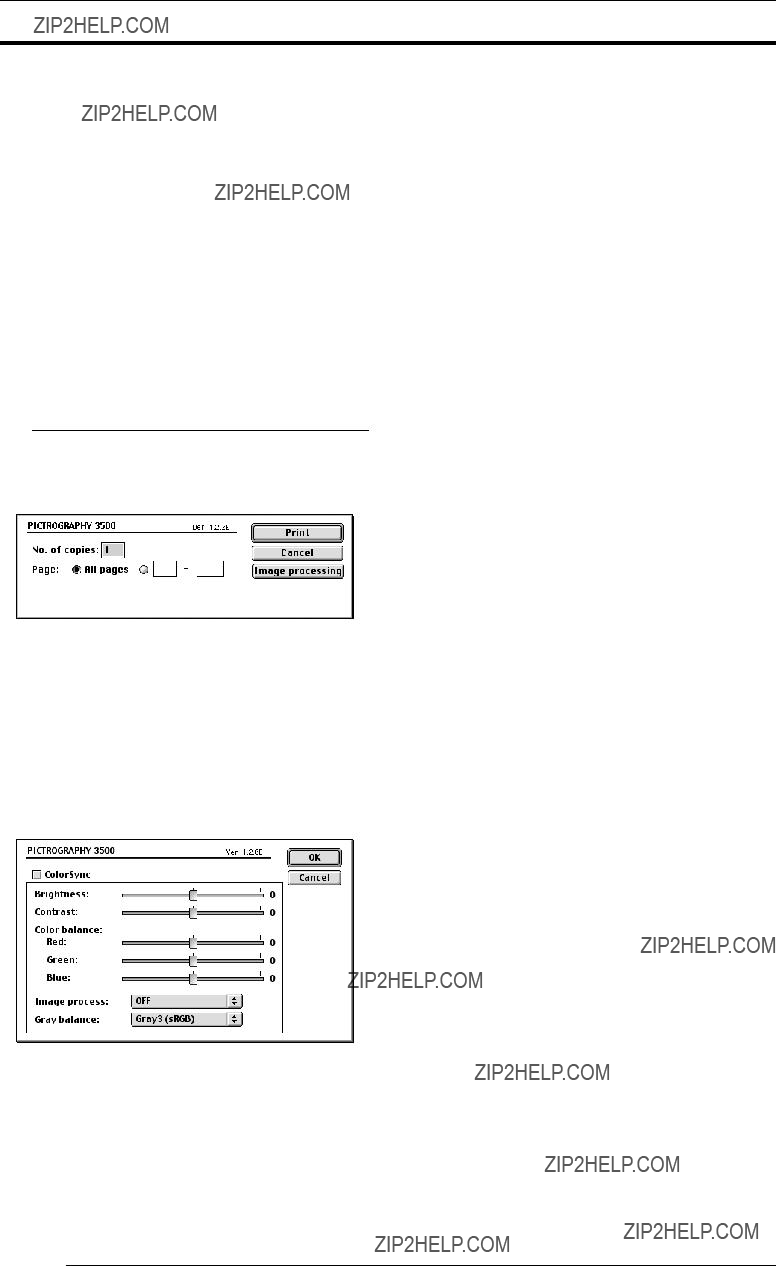
4. USING THE PRINTER DRIVER
When not checked:
*When printing from Photoshop, set the image resolution to 400dpi. If the resolution is set to any other resolution except 400dpi, jaggies may appear on images.
*When placing image data in PowerPoint, set the image reso- lution to 400dpi. If the resolution is set to any other resolu- tion except 400dpi, jaggies may appear on the image. After placing an image, jaggies caused by scaling the image up or down may appear on image.
*The printable size of V1.0 Mode when not checked is smaller than when checked. Refer to the printable sizes shown in the table below.
3.Setting print conditions
Open the print data file and select [Print] from the [File] menu. The following screen appears:
???Number of copies
Specify the number of copies you plan to print. The maximum number of copies is 50.
???Page
Specify the range of pages to print. You can select all pages, or specify a range using page numbers.
4.Setting image processing options
Click the [Image processing] button on the print condition setup screen.
The following screen appears:
???Brightness
Adjust the print density. Settings toward the right (plus direc- tion) result in lighter prints, while settings toward the left (mi- nus direction) result in darker prints.
???Contrast
Adjust the print contrast. Settings toward the right (plus direc- tion) produce higher contrast, while settings toward the left (minus direction) produce lower contrast.
???Color balance (Red/Green/Blue)
Adjust color balance for prints. Settings toward the right (plus direction) result in higher print density of the color specified, while settings toward the left (minus direction) result in lower print density of the color specified.
???Image process
Select a
???Gray balance
Select gray gradation and color balance, if Image process is set to OFF.
50

4. USING THE PRINTER DRIVER
???ColorSync
Check here to use the Mac OS color management function (ColorSync).
*The printer driver supports ColorSync version 2.5 or later. The driver is incompatible with earlier versions.
*For network printing, the server copy of ColorSync must also be version 2.5 or later.
Checking the ColorSync option displays the following:
???Matching method
Choose a color matching method (Rendering Intent) with ColorSync.
The following choices are available:
Profile Default: Identical to ???Perseptual???.
Relative Colorimetric:
Compensates for white color differences, as opposed to absolute reproduction.
Absolute Colorimetric:
Performs colorimetric matching. Colors out- side the color reproduction spectrum are poorly reproduced.
???Profile
Choose an ICC profile for ColorSync. Select [Pictrography3500
5.Printing
Click [Print] in the dialog box for print condition setup. Printing is executed.
4.2.3Different printing methods
1.Foreground printing
Printing occurs in the foreground if the user checks [OFF] in
[Background printing:] on the [Chooser] screen. In this case, the following screen appears when the print is initiated and print data is created. The Macintosh is unable to perform any other operation until the print data is completely transferred to the printer.
To abort printing, click the [Cancel] button.
2.Background printing
To enable background printing, check [ON] in [Background printing:] on the [Chooser] screen. If background printing is selected, the user is immediately returned to the application as printing starts and print data is created, permitting further work within the application. To abort printing, use Print Monitor. For information on Print Monitor, see the following subsection.
4.2.4Print Monitor
1.About Print Monitor
The Print Monitor (PGMonitor) utility monitors the print status and aborts printing during background printing.
To activate Print Monitor,
Once Print Monitor is launched, the following screen is dis- played:
???Status Display area (Upper part of the screen)
The upper part of the Print Monitor screen shows a document name and the print status for that document, if a print job is currently being processed.
???Spool list display area (Lower part of the screen)
The lower part of the Print Monitor screen shows a listing of document names and various data for those documents, if the print queue contains any jobs (spool files).
If another print job is executed when a print job is underway, the new job is appended at the bottom of this list.
51
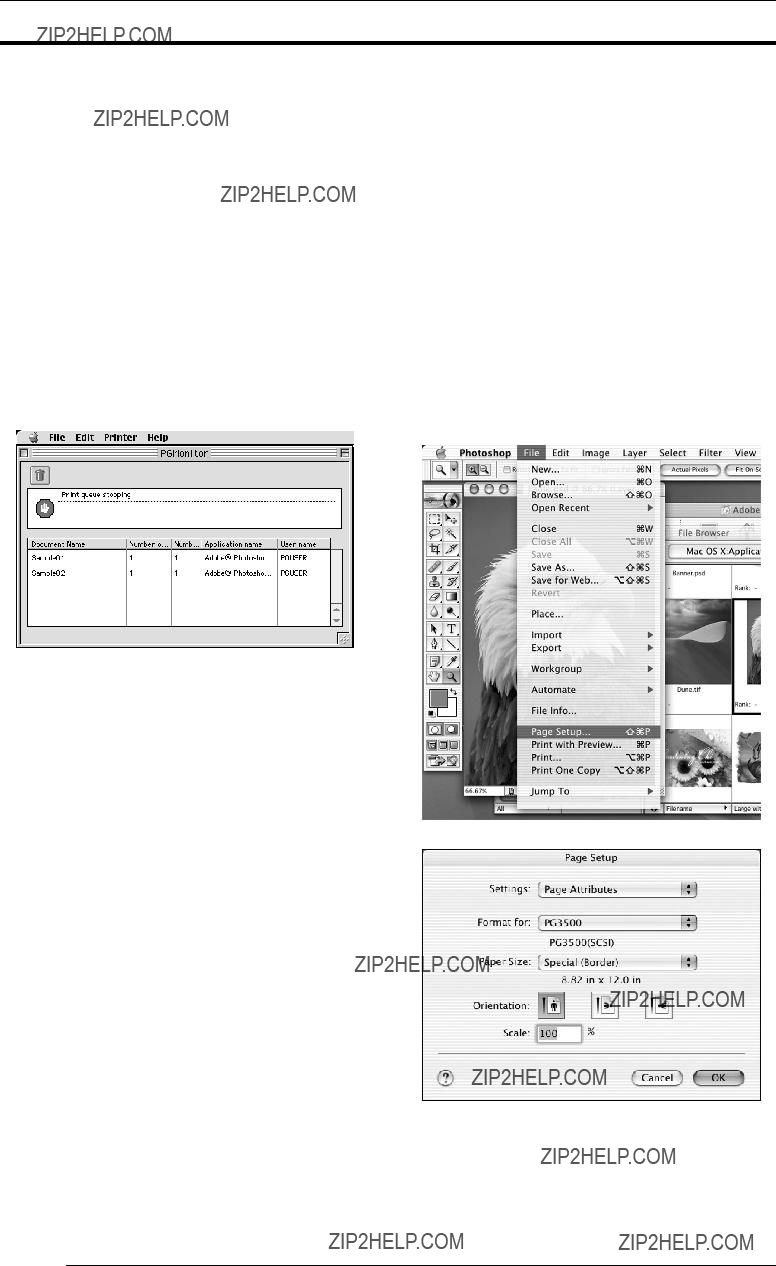
4. USING THE PRINTER DRIVER
2.Checking the print status Open Print Monitor.
If a print job is currently in progress, the corresponding docu- ment name and other data are displayed in the Status Display area (upper part of the screen).
Or, if the print queue contains other jobs to be printed, docu- ment names and other data are listed in the Spool List Display area (lower part of the screen).
3.Canceling printing Open Print Monitor.
Click [Print queue stop] in the [Printer] menu. If a print job is currently in progress, printing is suspended and the print job is moved to the Spool List Display area (lower part of the screen), where it is stored until printed .
The suspended print job is deleted from the Spool List if you click the document name in the Spool List Display area, then click the trash box icon.
To resume printing, select [Print queue start] from the [Printer] menu.
4.2.5ColorSync
1.Color matching by ColorSync
ColorSync is a Mac OS color management function that allows close matches between the colors displayed on a computer moni- tor and those output from printers.
To use ColorSync, click and check the [ColorSync] option in the [Image processing] dialog box.
*The printer driver supports ColorSync version 2.5 or later. The drive is incompatible with earlier ColorSync versions.
2.Choosing an ICC profile
Before printing with ColorSync color matching, you must specify an ICC profile (ColorSync properties).
Specify [Pictrography3500
*You can specify ???Source Profile??? on screen after you click
[ColorSync] on the [Control Panel] (When you use the OS Mac 9.0, click [Monitor] on the [Control Panel].).
3.Choosing a matching method
You can specify an execution method (Rendering Intent) for color matching.
For more information, see ???4.2.2 Print setup and printing???.
4.Color matching and network printing
To implement ColorSync color matching for network printing, both server and client computers must be running ColorSync. Both clients and server computers must support ColorSync ver- sion 2.5 or later.
4.3 Macintosh (Mac OS X)
This section describes printing with Macintosh computers running Mac OS X 10.2.1.
4.3.1Work flow through printing
???Launching an application (preparing print data)
Start the application software and create data to be printed. If you have already created a data file, open that file.
4.3.2Print setup and printing
The specific steps involved in printing vary with applications. For more information, see the instruction manual for the application. The procedure described below uses Adobe Photoshop 7.0 as an example.
1.Setting a paper size
Open the print data file and then select [Paper Setup...] from the [File] menu.
The [Page Setup] window appears.
???Format for
Select a destination to print (printer name).
*Be sure to select a destination to print. If another printer (or volume) is selected in this menu, printing may be performed incorrectly. If [Any Printer] is selected, printing is performed with the print size for the default printer.
52
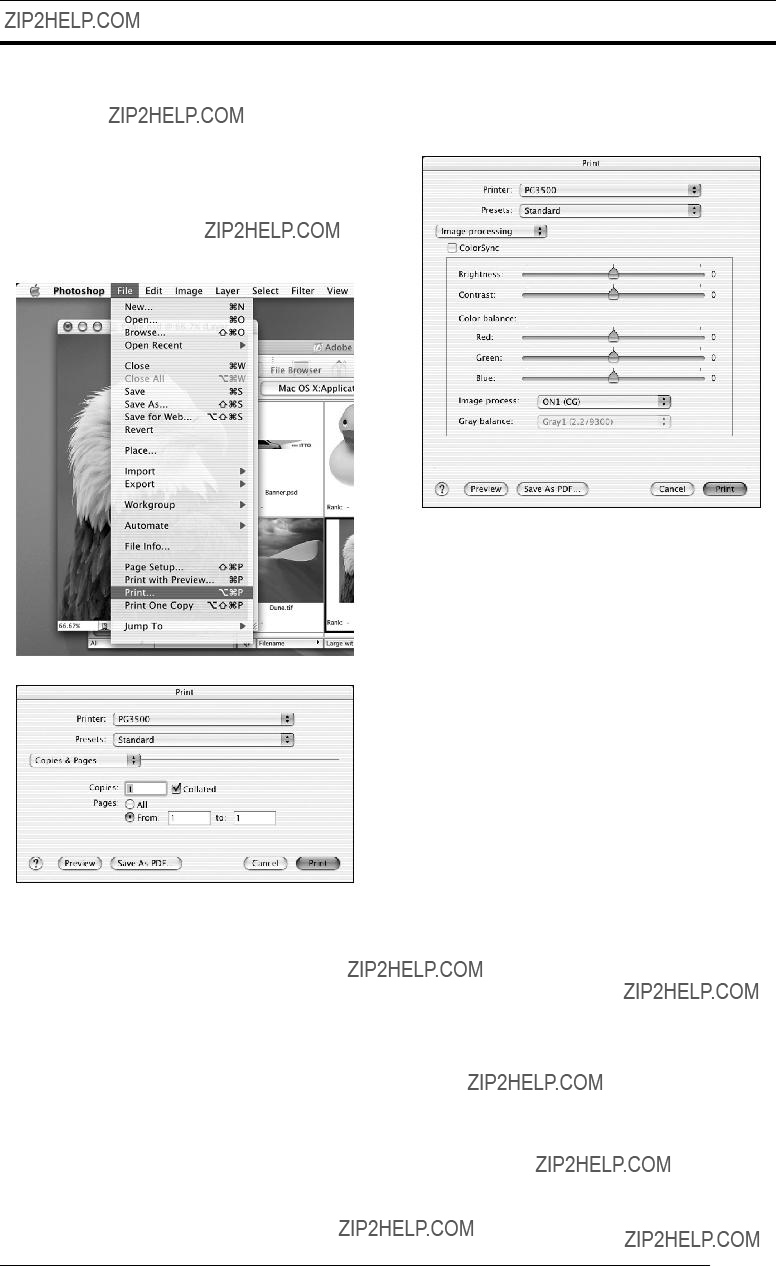
4. USING THE PRINTER DRIVER
???Paper Size
Select a paper size for printing.
Note that the printable paper size depends on the type of paper currently loaded in the PICTROGRAPHY 3500.
???Orientation
Select an orientation of printing.
2.Setting print conditions
Open the print data file and then select [Print] from the [File] menu.
The [Print] window appears.
???Printer
Select a destination to print (printer name).
???Copies
Specify the number of copies you plan to print. The maximum number of copies is 50.
3.Setting image processing options
Click the
[Image Processing]. The following appears.
???Brightness
Adjust the print density. Settings toward the right (plus direc- tion) result in lighter prints, while settings toward the left (mi- nus direction) result in darker prints.
???Contrast
Adjust the print contrast. Settings toward the right (plus direc- tion) produce higher contrast, while settings toward the left (minus direction) produce lower contrast.
???Color balance (Red/Green/Blue)
Adjust color balance for prints. Settings toward the right (plus direction) result in higher print density of the color specified, while settings toward the left (minus direction) result in lower print density of the color specified.
???Image process
Select a
53

4. USING THE PRINTER DRIVER
???Gray balance
Select gray gradation and color balance, if Image process is set to OFF.
???ColorSync
Check here to use the Mac OS color management function (ColorSync).
Checking the ColorSync option displays the following:
???Profile
Chooses an ICC profile for ColorSync. Select
4.Click the [Print] button. Printing is executed.
4.3.3Print Center
4.3.3.1Print Center Outline
Print Center is used to monitor the print status or abort a printing process during printing. To launch Print Center, click the [Print Cen- ter] icon in Dock on the desktop. When Print Center is launched, the following window opens.
???Status Display area (Upper part of the screen)
The upper part of the Print Center screen shows a document name and the print status for that document, if a print job is currently being processed.
???Spool List Display area (Lower part of the screen)
The lower part of the Print Center screen shows a listing of document names and various data for those documents, if the print queue contains any jobs (spool files).
If another print job is executed when a print job is underway, the new job is appended at the bottom of this list.
4.3.3.2Checking the print status
Click the [Print Center] icon in Dock on the desktop. The [Print Center] window appears. If a print job is currently in progress, the corresponding document name and other data are displayed in the Status Display area (upper part of the screen).
Or, if the print queue contains other jobs to be printed, document names and other data are listed in the Spool List Display area (lower part of the screen).
4.3.3.3Canceling printing
Click the [Print Center] icon in Dock on the desktop. The [Print Center] window appears. Click the [Stop Jobs] button. If a print job is currently in progress, printing is suspended.
54
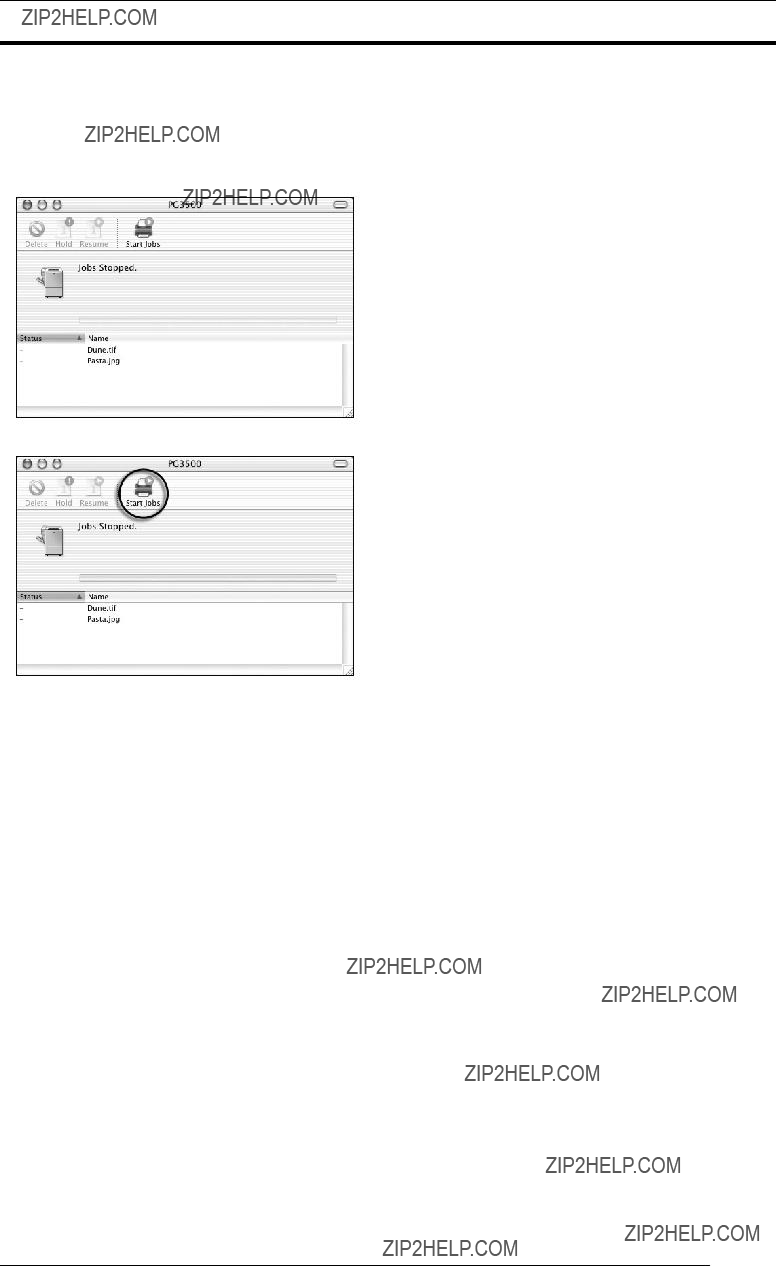
4. USING THE PRINTER DRIVER
Printing of the suspended print job is held if you click the document name in the Spool List Display area and then click the [Hold] button. The held condition is canceled if you click the [Resume] button. The suspended print job is deleted from the Spool List if you click the document name in the Spool List Display area and then click the
[Delete] button.
To resume printing, click the [Start Jobs] button.
55

5. ERROR MESSAGES
This section describes error messages associated with the PICTROGRAPHY 3500 printer driver.
???PICTROGRAPHY not found.
Check to see if the PICTROGRAPHY 3500 is powered on.
Check to see if the PICTROGRAPHY 3500 and host computer are properly connected.
Check to see if ASPI Manager is installed in the computer (Windows only).
???Wrong paper size.
Print cannot be executed for the paper size specified. Replace the pa- per currently loaded in the PICTROGRAPHY 3500 with one of the correct roll width or change the paper size setting.
???Water level detection error.
Insufficient water for coating. Check for clogs in the water supply tube running from the water bottle.
???Insufficient water (low water level in bottle).
Refill the water bottle to the prescribed water level.
???Donor has run out.
Replace the donor.
???Paper has run out.
Replace the paper.
???Replace water bottles.
Change the water in the bottle.
???Used donors are full.
Dispose of the used donors.
???Replace water filters.
Replace the water filters.
???No donor magazine set.
Load a donor magazine into the machine.
???No paper magazine set.
Load a paper magazine into the machine.
???No water bottle available.
Load the water bottle.
???No water filter available.
Install the water filter.
???Printing is not possible with the presently loaded paper.
Printing cannot be executed on the paper size specified. Replace the paper currently loaded in the PICTROGRAPHY 3500 with one of the correct size, or change the paper size setting.
Example: If the paper type is OHP, you cannot print with [A4 (un- framed)] selected for paper size.
???Error detected in PICTROGRAPHY body. Error code:
Take appropriate action for the error code after referring to the instruc- tion manual for the PICTROGRAPHY 3500 main body.
???A communications error with the PICTROGRAPHY has been detected.
Check to see if the PICTROGRAPHY 3500 and the host computer are properly connected.
Windows:
???"Bilateral communication function" not enabled.
Windows 95 / 98:
Check in [Enable
Windows NT 4.0 / 2000 / XP:
Check [Enable
???"file name" not available. File not found or broken.
???"file name" version does not match.
Reinstall the PICTROGRAPHY 3500 printer driver.
???Print data do not match.
This error message is displayed if the user attempts to print to PICTRO SCSI Port using another printer driver. PICTRO SCSI Port does not support printing with any other printer driver.
???Retry
This message indicates either that the PICTROGRAPHY 3500 is offline or unable to print because it is engaged in some other processing. Put the PICTROGRAPHY 3500 back online, or resend the print command after waiting for it to complete the current processing.
???The message transmission has failed.
Check to see that the server and client computers are connected across the network.
???The PICTROGRAPHY message transmission has failed. Error code: XXXX
Check to see that the PICTROGRAPHY 3500 and host computer are properly connected.
???Failed to secure memory.
Increase available memory space by closing other applications.
???Error detected in print monitor. Error code: XXXX
The system has become unstable, or the printer driver may not have been installed properly. Restart the computer. If this does not correct the problem, reinstall the FUJIFILM PICTROGRAPHY3500 printer driver.
56

5. ERROR MESSAGES
Macintosh:
???Failed to obtain printer information. Reselect printer using selec- tor.
Reselect the PICTROGRAPHY 3500 with [Chooser].
???Connection to server not set. Set an appropriate server.
Network printing requires a server. When the server setup dialog box is displayed, enter settings in the [PictroGraphy] folder (previously mounted) on the computer directly connected to the PICTROGRAPHY 3500.
???Connection to server not found. Make sure if it is sharable.
Check to see that the server and client computers are connected across the network.
Enter settings to enable sharing of the server [PictroGraphy] folder. Mount the [PictroGraphy] folder on the server.
???Failed to obtain printer information. Reset connection to server.
Reset the connection to the server ([PictroGraphy] folder on the com- puter directly connected to the PICTROGRAPHY 3500) using the
[Chooser].
???Specified paper differs from that in printer. Specified paper size: XXXX
The system is unable to print on the specified paper size. Replace the paper currently loaded in the PICTROGRAPHY 3500 with one of the correct roll width, or change the paper size setting.
???Printer error. Printer may be offline.
???Printer exclusive use not permitted. Printer may be offline or used by another computer.
???Failed to obtain paper information since PICTROGRAPHY is printing or offline.
This message indicates that the PICTROGRAPHY 3500 is offline or unable to print because it is engaged in some other processing. Put the PICTROGRAPHY 3500 back online, or resend the print command af- ter waiting for the other process to complete.
???Necessary file not found.
Reinstall the PICTROGRAPHY 3500 printer driver.
???The print server is set to foreground printing.
Setting the server to foreground printing disables network printing. To implement network printing, set background printing On on the server side.
???Background printing is in progress. Background printing cannot be turned off at this time.
To implement network printing, background printing on the server side must be On. While network printing is in progress, the setting for back- ground printing cannot be set to Off. Wait for all documents to finish printing, or delete the documents in the queue.
???The specified ColorSync profile not found.
The ColorSync profile specified for network printing is not installed in the server. Install ColorSync in the server.
???Memory shortage.
Increase available memory by closing other applications.
57
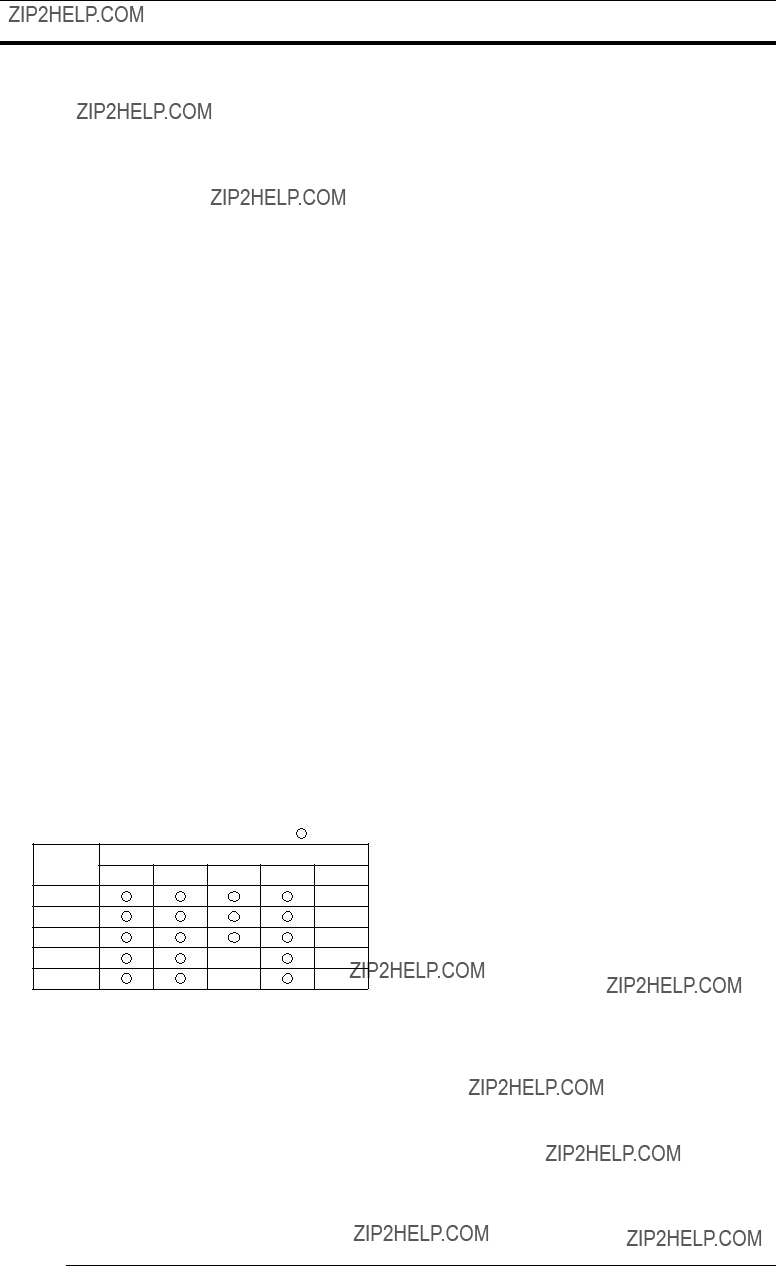
6. RESTRICTIONS
6.1Windows
1.Installing the printer driver without connecting the PICTROGRAPHY 3500 (Windows 95/98)
While it is possible to install the printer driver in a computer without first connecting the PICTROGRAPHY, or with the printer switched off, the PICTROGRAPHY 3500 after installa- tion will then be detected as a new device the next time Win- dows launches with the PICTROGRAPHY 3500 connected or powered on, causing the printer driver to be installed again.
We recommend installing the printer driver after first connect- ing the PICTROGRAPHY 3500.
2.About setup for paper size
Some applications allow you to set paper size through their own dialogs. In such cases, paper size settings selected in the printer driver may be ignored.
3.About setup for direction of paper
Some applications allow you to specify the direction of paper through their own dialogs. In such cases, settings for the direc- tion of paper selected in the printer driver may be ignored.
4.About setup for number of copies
The number of print copies may sometimes be specified through an application dialog. Some applications may permit even more copies than the maximum (50) permitted by the PICTROGRAPHY 3500. If a number greater than 50 is selected, the printer may output only a single copy.
5.Precautions for using ICM
The PICTROGRAPHY 3500 printer driver supports color man- agement function by ICM. However, some applications (such as Photoshop) implement their own color management function. If you set color management functions for both the application and the printer driver, you will obtain incorrect color matching. To use an application's color management function, disable ICM for the printer driver, set Image Process to OFF, and Gray Bal- ance to Gray3.
6.Restrictions for Network Printing
When network printing with a shared printer, there are restric- tions depending on the printing environment as shown below.
Network Printing Environment
???Restriction A
When Windows XP is used as the server OS, depending on the Windows XP settings clients may not be able to use the printer. When network printing, change the server Windows XP set- tings as follows.
*Logon the system by using the ???Administrator??? account to change the settings.
1.Windows XP Professional
Clients can use the network printer using Windows XP Pro- fessional as the server OS, after taking some of the mea- sures (a), (b) or (c) as follows.
If Windows XP has been installed on an NTFS formatted
drive, take measures (a), (b) or (c) as follows. If Windows XP has been installed on a FAT32 formatted drive, clients cannot print using Windows XP as the server OS.
(a)Use Windows XP in the domain environment. (Put the Windows XP computer under domain control.)
If Windows XP is used in the work group environment, take measures (b) or (c) as follows.
(b)Open the [Folder Options] screen, click [View], then in
[Advanced settings:], uncheck the box [Use simple file sharing (Recommended)].
To open the [Folder Options] screen, click [Start] > [Control Panel] > [Appearance and Themes] > [Folder Options].
(c)Open the [Local security Settings] window, click [Se- curity Settings] > [Local Policies] > [Security Op- tions] to display the policy list. Next,
work access: Sharing and security model for local accounts] on the list and change the setting to [Classic - local users authenticate as themselves].
To open the [Local Security Settings] window, click [Start] > [Control Panel] > [Performance and Main- tenance] > [Administrative Tools] > [Local Security Policy].
2.Windows XP Home Edition
Clients cannot print using Windows XP Home Edition as the server OS.
???Restriction B
When network printing from clients using Windows 2000 or Windows XP connected to the Windows NT4.0 server OS, the ICM function cannot be used.
This is because Windows NT4.0 does not support the ICM function. In a Windows
6.2Macintosh
1.When printing from Photoshop
When printing from Photoshop, image edges (right side and lower side) may not be printed for several lines. While PICTROGRAPHY 3500 provides a print resolution of 400 dpi, when Photoshop images are printed at this resolution, the num- ber of pixels of the Photoshop images and the printed images may not match each other exactly.
2.Treatment of fonts in network printing
In network printing, if you print a document using fonts not in- stalled in the server is printed, those fonts are replaced with other fonts during printing. Additionally, the font layout may be dis- rupted due to differences in the character width of some font types.
When planning on network printing, be sure to install the same fonts on the server and client side.
3.About setup for direction of paper
Some applications allow you to specify the direction of paper through their own dialogs. (FREEHAND, etc.)
In such cases, settings for the direction of paper made in the printer driver may be ignored.
58

6. RESTRICTIONS
4.About the print quality of rotated characters
The print quality obtained when printing rotated characters de- pends on the application from which printing occurs.
Since the PICTROGRAPHY 3500 printer driver does not sup- port picture comments, the print quality of rotated characters is often poorer than that of
5.Notes on use of ColorSync
The PICTROGRAPHY 3500 supports the color management function provided by ColorSync. However, some types of ap- plications from which print is made will support a color man- agement function of their own. (Photoshop, etc.)
In such cases, keep in mind that appropriate color matching will not be obtained if the color management function is enabled on both the application and the printer driver side.
To use the color management function provided on the applica- tion side, disable ColorSync on the printer driver side and set Image Process to OFF and Gray Balance to Gray3.
6.To print on Mac OS9
When printing from Mac OS 9, the following restrictions apply:
???When
???When
???When
To end the print, log in to the server from the owner or an ordinary user, and delete the relevant document through the Print Monitor.
???When
???A restricted user or panel user intending to utilize Print Moni- tor will have to register Print Monitor as [User's Application] at
The problems mentioned above will not be the case, if Multi- user is deactivated (OFF), or if the owner logs in when Multi- user remains active (ON).
7.To print on Mac OS X
When printing from Mac OS X, the following restrictions apply:
???After starting up a Photoshop
???After adding a printer using Print Center, if a Photoshop plug- in is started up without Print Center quit, the following error message is displayed. Be sure to quit Print Center before start- ing up a Photoshop
???Error messages may not be displayed when the PICTROGRAPHY 3500 is turned OFF, or is not connected to a network. If printing is not performed while "Printing job" or "Opening printer connection" remains on the Print Center screen for a long time, check whether or not the PICTROGRAPHY 3500 is turned ON, and is connected to a network correctly.
???When printing is performed with the [Collated] check box marked with a " ??? " (default setting) in [Copies & Pages] of the [Print] screen, data transfer to the printer is repeated for a number of times equal to the designated number of copies. Remove the " ??? " mark from the [Collated] check box for higher efficiency when multiple copies are made for a
???When printing an image from Photoshop 7.0, if the size of the image is equal to the designated paper size, the image edges may not be printed for several lines.
???When printing from Illustrator 10, collated printing is not per- formed even if the [Collated] check box is marked with a " ??? " in [Copies & Pages] of the [Print] screen.
???The print queue or print job in Print Center may not be con- trolled by the user depending on the timing of operation.
???The positioning or scaling up/down function may not work correctly depending on applications.
<Restrictions regarding Printer Sharing>
???Install the printer driver onto the client computers as well as server computer. Even if the printer driver is not installed, cli- ent computers can perform printing with a shared PICTROGRAPHY. However, paper sizes supported by the shared PICTROGRAPHY cannot be selected.
???When printer sharing is set to "ON" on a computer, all printers displayed on [Printer List] of Print Center are shared.
???If shared printers are not displayed on the [Printer]
59

6.RESTRICTIONS
???On [Printer List] of Print Center, shared printers are displayed with a colored background.
???If a computer runs Mac OS X 10.1.x or earlier (including Mac OS 9 or earlier), the computer cannot recognize the printers shared with the printer sharing function of Mac OS X 10.2.1 or later.
???During printing process, print status display of Print Center is fixed to "Waiting for job to complete..." on the client com- puter.
???Client computers cannot handle (stop, hold or delete) print jobs. Only the server computer can handle print jobs.
???An error
???When a printer error is detected while processing a print re- quest from a client computer, if Print Center on the server com- puter is not active, the error message is not displayed.
6.3Others
1.Network printing in a mixed environment of Windows and Macintosh
If the server is a Windows computer in a network printing situ- ation, the client(s) must also be (a) Windows computer(s). Likewise, if the server is a Macintosh computer in a network printing situation, the client(s) must also be (a) Macintosh computer(s).
Print cannot be made from a Windows client through a Macintosh server, or conversely, from a Macintosh client through a Win- dows server.
2.To print a document with an ESP file linked
The PICTROGRAPHY 3500 is a
Some applications allow to embed the EPS file into the docu- ment, instead of linking the file to the document. In that case, the images created by the applications will be printed (the im- age quality depending on the applications).
60

FUJI PHOTO FILM CO., LTD.
<FUJIFILM ABROAD>